Don't wanna be here? Send us removal request.
Text
A Week in Rome
I journeyed over to CPH airport at around 6 PM to make it to my 8:30 PM flight on Friday night. After some difficulties, I made it to my home for the week at 2 AM.
Saturday
A late start to the day, I had nothing planned... and so began my first day wandering around the city without a particular destination in mind.

My first view of St. Peter’s Basilica. The sheer size of the building and the number of sculptures placed atop the structure, surrounding the square was quite an amazing sight to see.
I was taken aback by the sheer number of tourists surrounding the more famous places in Rome, I’ve never seen so many anywhere I have been... they are paradoxically beneficial and detrimental to the city. While tourism brings money and activity into the Roman economy, it also brings piles of garbage from careless littering and city spaces blocked off to the locals.

I found myself walking along the River Tiber. It was quite beautiful (save for the garbage within it and the general neglected decay of the areas bordering the river) and it served me well as a means to navigate my way through the city.

Another view of the river... an abandoned houseboat and small dock falling apart off in the distance. According to myth the founders of Rome, Romulus and Remus were cast off as infants on the banks of the Tiber River under the order of their Uncle, King Amulius... they were seen as threats to the throne. The brothers were later saved by Tibernus, God of the Tiber River, at the site that would grow to become Rome.

The Temple of Fortuna Virilis (”manly fortune”). Dedicated to the god of keys, doors, granaries, and livestock... Portunus. The building that stands now was constructed around 120-80 BCE. It is one of the greatest examples of classical architecture of the Ionic Order (there are three: Ionic, Corinthian, and Doric). It is one of the best preserved ancient buildings in Rome.

I cannot deny that the extremely hearty Roman food and it’s equally hearty people demand high regard.
I learned a lot about the simple and very rich food during my week here... and in turn learned a bit about the people that cook and eat the cuisine.
Campagna Amica Market was my stop for my first meal in Rome. Open only on weekends from 8 AM to 3 PM along a road near Circo Massimo, the place was filled with locals getting their fill of fresh produce, meat, seafood, bread, sweets, olive oil, and wine (and a few tourists, who knew what to do with themselves along a spectrum of absolute confidence to embarrassing incompetence, I was on the latter end).

After four embarrassing exchanges in Italian, English, body language... I managed to pull together I little meal for myself. It doesn’t look like much, but it was quite delicious. A loaf of bread filled with walnuts and olive oil, some fresh ricotta, some cured pork with red pepper flakes, fennel seed, and black pepper, and a very very ripe persimmon (they are going to keep their good persimmons for their regulars). Unfortunate the most Roman grocery stores and markets warrant so much packaging for their food.

I ate my lunch at Circo Massimo, the ruins of a chariot racing stadium. It was once the largest stadium of the Roman empire. I eventually went back to the market to escape the heavy wind that kept kicking up dust from the field.

Back in the market, I was given some charcoal roasted hazelnuts and squash + a bit of wine from some of the people managing the market. I sat for an hour or two watching the group of men and women, a few kids... working together cracking, cooking, and distributing the hazelnuts to visitors and friends.

I found myself before the Colosseum and the Arch of Constantine. The triumphal arch was built in AD 315. The arch interestingly reuses a number of pieces from other older imperial monuments of the 2nd century (piecing together other pieces like a collage is called spolia.
Taking old pieces of ruins/other monuments was quite common for Baroque architects (late 16th century) (many of the churches of Rome are of the Baroque style)).

The Arch of Titus, constructed in 82 AD to commemorate the war victories of the then recently deceased Emperor Titus, including the Siege of Jerusalem.

A detail of the Arch (not pictured in my photo). Depicts the spoils of the extraordinarily gruesome Roman attack on Jerusalem (stemming from a Jewish uprising within Judea, a Roman-held province). Much of the spoils coming from the Jewish Temple... one of which is the giant golden menora seen left from center.

The Colosseum, created in 70 AD and opened in 80 AD. Titus (the son of Emporer Vespasian, the one who began construction) opened the Colosseum, adding to his popularity in Rome.

A view of a residential area on my way back to the flat I was staying in.
Sunday

A view of Rome from Villa Borghese park near the Spanish Steps and Villa Medici.

A fountain within the Pincio Promenade. I recommend coming here to escape the swarms of tourists and busy car paths, its a pleasant place to wander... filled with large wavy trees... there are a great number of statues and busts dispersed amongst the area.

Old Bridge Gelateria, no artisan crafted ice cream or unique flavors... or something along those lines... like some of the other “top gelato” places mentioned in articles by Eater and the likes... but this is one of the Roman classics for some simply good gelato. My friend and I ordered three flavors: crema (eggs, cream, sugar), chocolate, pistachio.

Castel Sant’Angelo or the Mausoleum of Hadrian initially commissioned as a massoleum for Emporer Hadrian and his family in 123 - 139 AD. It was later used as a fortress and castle by the popes... it is now a museum. The ashes of Hadrian and his family + some of the popes are likely held deep within one of the Treasury rooms within the building.

Altar of the Fatherland, built in the honor of the first king of a unified Italy (Victor Emmanuel. The building’s construction began in 1885 and was completed in 1925 in the Neoclassical architectural style.

View from the top of the Altar of the Fatherland. The easy to access spot provides a nice view of the many ancient Roman ruins within the area.... this view shows a portion of the Imperial Forum (?).

Another view from the same vantage point.

Michelangelo’s Moses with San Pietro in Vincoli... part of Pope Julius II’s tomb, which was originally commissioned in 1505 (with a much grander scale and design in mind) but not completed in 1545 (with great difficulty, inconsistency, changes in plans/scale/commissions ... the work troubled Michelangelo for 40 years of his life).
Monday
Today I wandered to a variety of churches and other landmarks south of where I was staying.

I first stopped for lunch at Mercato Testaccio to continue with my exploration of the different food markets scattered throughout the city. I wandered through the aisles, looking at the usual spreads of fresh produce and groups of Romans doing their mid-day grocery shopping.
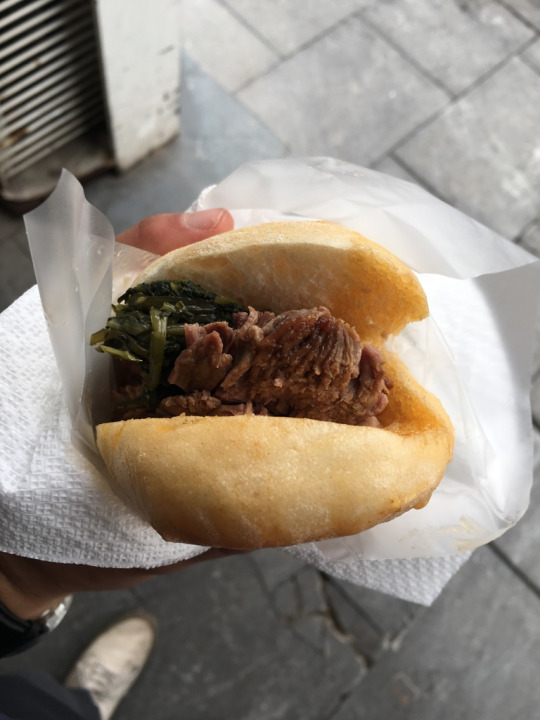
I stopped by Mordi e Vai, a humble deli space ran by a man named Sergio Espesito who serves up classic Roman slow-cooked meals between two simple bread rolls. I ordered #1, allesso di bollito, brisket with bitter greens... the bun is dipped in stewing broth that holds the brisket.

After lunch, I wandered a little southeast to the Protestant Graveyards. Romanticist poets Percy Bysshe Shelley and John Keats are buried here.
Keats died of Tuberculosis in 1821 at the age of 25, his tombstone reads...
This grave contains all that was mortal, of a young English poet, who on his death bed, on the bitterness of his heart, at the malicious power of his enemies, desired these words to be engraven on his tombstone: Here lies one whose name was writ in water.
Shelley drowned while sailing along the Italian Riviera a year after Keats, his tombstone reads...
Nothing of him that doth fade, // But doth suffer a sea change, // Into something rich and strange. (A quote from Shakespear’s The Tempest)

I walked North, wandering through a number of small churches and parks on my way to the Roman Forum... once the heart of the ancient city’s government, trade, and culture.

I surveyed the Roman Forum from the Capitoline Hill Plaza, designed by Michelangelo.

I concluded my Monday adventure at one of the oldest wine shops in Rome, Ill Gocceto. I enjoyed watching the servers swiftly open wine bottles and pour while conversing with regulars. They’d pop the corks with a flourish of speed as they made their rounds through the busy shop.
Tuesday
I wandered East to visit the Ecstasy of St. Theresa by Gian Lorenzo Bernini in the Cornoaro Chapel of Santa Maria della Vittoria. I planned to stop by a number of places on my way to the destination.

I stopped by the landmark Fountain of the Four Rivers, also desgned by Bernini. The base of the fountain represents River Gods belonging to four major rivers within the four continents subject to papal authority: the Nile of Africa, the Danube of Europe, the Ganges of Asia, and the Rio de la Plata of the Americas.

For a snack I visited Forno Campo de’ Fiori, a historical bakery known for its classics like pizza rossa and pizza bianchi. Rossa is a thin pizza crust topped with a rich tomato sauce. Bianchi is even simpler, just pizza crust brushed with olive oil and speckled with flaky sea salt.

After my snack and a couple small stops, I made it to my destination. The Bernini’s Ecstasy of St. Teresa is considered one of the central sculptural masterpieces of the Roman Baroque period that spanned from the 17th to the 18th century. The group’s imagery comes from the autobiography of Teresa of Avila:
I saw in his hand a long spear of gold, and at the iron's point there seemed to be a little fire. He appeared to me to be thrusting it at times into my heart, and to pierce my very entrails; when he drew it out, he seemed to draw them out also, and to leave me all on fire with a great love of God. The pain was so great, that it made me moan; and yet so surpassing was the sweetness of this excessive pain, that I could not wish to be rid of it...

After reaching my destination, I enjoyed the long walk home to the light of the setting sun.
Wednesday
I got up early in the morning to get in line for the Vatican Museum. I planned well as I was the first in line behind the many hundred that congregated behind me as the time to open drew closer.
I did not take many photos while I was in the museum, I left my phone off to focus on what was in front of me.

The mysterious Belvedere Torso is a fragment of a statue from the 1st century BC. Over time the statue was damaged and lost to be rediscovered in the 15th century. was highly influential to artists of the Renaissance Michelangelo who uses the Torso’s iconographic form in many of his own statues and paintings.

One of Francis Bacon’s pieces from his study of Diego Velásquez’s Portrait of Pope Innocent X. Supposedly the study produced around 50 pieces between the 1950s and 1960s. The most well-known pieces from the study are those that are a part of the “screaming pope” series
Friday
I couldn’t do much Thursday, the storm was too strong to take the long walks needed to explore Rome.
I woke up early Friday to get into St. Peter’s Basilica, mainly to see Michelangelo’s Pieta.

I ended by Roman adventure at Mercato Trionfale, the largest market in Rome with an astonishing array of vendors.

Although the market is said to be the most busy in the mornings, my mid-day visit was still overwhelming. I didn’t buy anything, I just wandered through the aisles and watched the exchanges occur. I wished I spoke Italian to understand the conversations I would walk by, the way in which the produce is bought.
Saturday
I returned home on Saturday, I spent most of the day waiting for my departures at the train station and the airport... I watched people walk by and wrote in my notebook.

From the floor of Roma Termini, waiting for my train to the airport. I was glad to return to Denmark.
4 notes
·
View notes
Text
A Quick Bit Before Rome
I am posting this from my room in Rome... there is quite a storm going on right now so I figured this would be a good time to touch on some things I did between Long Study Week and Rome.
Over the two weeks between the two trips, the colors (and weather) of Fall had quickly made its arrival. The trail I usually run along in Furesø Park became buried by leaves of brown, red, orange, and yellow. The leaves that continued to cling to their branches (despite heavy Danish winds), danced with the gusts and reflected the sunlight that moved along the horizon of the very long Northern sunset. (the sunset takes quite long, I enjoy the colors for the entirety of my run).

The color palette of the Danish Fall. The colors of the leaves are made even brighter with the similar color of the setting sun.

The sunset and my favorite dock. I often stop here to enjoy the sunset before finishing the last kilometers of my run. The spot provides a rather wide view of the lake and it serves as a great spot to take a dip as many from the neighborhood do.

The view from the dock. The whole lake carries the colors of the sky and the sun. Sitting on the dock edge with feet hanging over is like sitting above a sunset.
My friend visited me the weekend between trips (he is studying in Florence). I gave him a tour around Copenhagen by bicycle... the route we took was determined by the food stops I wanted to take.
Friday night he arrived late... I decided to take him around the town before heading home for the night. We stopped for a drink at BRUS (I mentioned this place before when I visited BÆST).
Saturday morning we started our day at Café Det Vide Hus, a small coffee shop near Nørreport in the direction toward Kaningsgården.

The view from the 2nd floor interior. I enjoyed a nice espresso.

Scrambled eggs with cheese, chorizo, chives, sorrel on buttered rye. Avocado with chives, seeds, sorrel on buttered rye (with flakey salt and pepper flakes).
We found a rental bike for the day and made our way to Refshaleøen. We took the long way to cross the bike bridge, to see Island Brygge’s swimming dock, Christiania’s neighborhood, and Noma’s entrance.
Our first stop in Refshaleøen was Lille Bakery. This place is amazing. Established within one of the many warehouse-like buildings in the formerly industrial area (I think it was a shipyard?), the bright sun shines in to illuminate the already bright and happy locals and visitors enjoying baked goods, amazing plates of food, and drinks. This place (along with all of Refshaleøen) is a must-visit when in Copenhagen... it is uniquely CPH.

The bustling ground floor... the kitchen isn’t very separated from the dining area... the Lille Bakery team seem to be hanging out and enjoying themselves as much as the guests (good vibes).

Left: a donut (?) dipped in sugar with (if I can remember) raspberry powder and filled on the spot with a raspberry creme (there are other flavors too). Didn’t do to well in remembering the bite.
Right: a crazy good chocolate cookie, chewey, rich, very well-made... that’s all I need to say.

A savory beetroot tart. A croissant-like crust carried the rich, buttery, sweet-nutty beets filling. Topped with acidic creme-fraiche and dressed-up bitter radicchio with nuts tossed in to it... parsley (?), salt, pepper on top. This was damn good and I can’t describe it... oh well, you’ll just have to go and taste some things they make there for yourself.

An unusual knick-knack shop... a curious collection of things from generations ago. Lots of vinyl records (can’t promise they are in good condition), a mix cool postcards, and a whole bunch of things that I frustratingly would not be able to take in the flight home with me. The spot is near Reffen, look for the sign.

A smokey break in Reffen. This is a cool spot, there is an exciting mix of cuisines... there is something for everyone. I enjoyed a bowl of polenta topped with a vegetable stew, olives, Parmigiano-Reggiano (?)... my friend had a traditional Danish hot-dog (can’t say it was the best introduction... go to a DØP stand or John’s Hot Dogs in Kødbyens). After some food we hung out around one of the many fireplaces they had laid out for guests... the wood they used didn’t burn very well, the smoke did give me a campfire-smell for the rest of the day (a favorite smell).

Grabbed a beer at the Mikkeller Brewery in the area... I am not a huge fan of beer but I enjoyed what was being served here.
We had dinner at (my favorite) La Banchina. They are holding winter dinners and I knew I had to book a table.

Our view as we sat down for dinner.

Just some really good sourdough bread and olive oil.

The second dish, raw trout encased by a roll of fresh turnip in a broth of horseradish cream and dill oil.
(the first was a small plate of preserved pickled cherries in Woodruff oil followed by a mix of fresh nasturtium flowers, fried nasturtium leaves, a buttermilk chaser).

The third dish, hen of the woods broth with enoki mushrooms, pickled zucchini, some flowers and wood sorrel... all atop some brown butter.

The fourth, charred broccoli and chard greens atop a sauce of smoked cheese with cured egg yolk and parmesan (?).

Insanely good unfiltered The whole flavor of the grapes remained while creating a subtle but complex flavor and aroma. There was a delicate earthiness to it and a very subtle spice like white peppercorns. Gaia 2016 - Cantina Giardino

Fifth course, baked hake with fresh and pickled seaweed. Topped with a crumble made from remaining Hake and seaweed, along with sesame seeds... served with a fish sauce and mussels.

The sixth course, yellow beet sorbet atop a bed of cooked apples and raw badger flame beet. The badger flame beet is highly prized for its taste when served raw and its color

Finished the meal with an espresso and some preserved candied apples.

Studied at the Ny Carlsberg Glyptotek... general entry is free on Tuesdays. Highly recommend stopping by during that time.

A nice view of some cows grazing in their pasture between the forests of Bøndernes Hegn south of Furesø.

Our architecture class visited Sluseholmen... a heavy industrial area turned residential in the 2000s. I loved the way the homes are connected to canals. When the weather allows, this would be the best backyard... (I am a swimmer, being able to go for a swim in a big body of water right out your back door would be quite awesome).

That’s all, next I will be talking about my visit to Rome.
1 note
·
View note
Text
Long Study Tour: Hamburg & Berlin
SUNDAY
6:45 Meet tour leaders and the group at Copenhagen Central Station
Up at 4:40, I gathered my things and myself to make my way to the station. I forgot to lock my bike (thank god for host moms, my bike likely would have disappeared otherwise). It all went well otherwise, I boarded the bus with my class in a daze.
7:10 Depart by bus for Rødby (Bus 38)
We then made a switch from bus to train. The train boarded the ferry.
9:35 Depart by ferry to Germany Depart on train (EC 38) to Hamburg

The train boards the ferry, we walk amongst the ferry (which is really a mall on the inside, may as well sell things to people when you’ve got them captive for the 40 minute crossing to Germany). It’s a pleasant ride, we talk on one of the two outside docks... watching the other boats pass, the whitewater trail we leave, the wind, the sun.
Photo Link
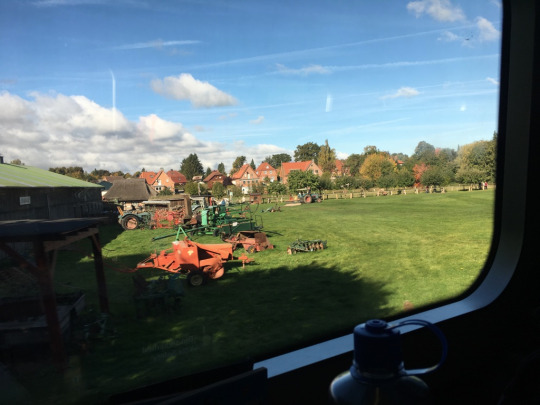
A view from the train. A town view of the Lensahn municipality within Schleswig-Holstein, Germany.
12.31 Arrive at Hamburg Hauptbahnhof Walk from station to hostel

Hamburg’s central station. Bustling with people of all sorts, all in a bit of a hurry to be somewhere. It’s quite something to shuffle through shifting rivers of people with all the luggage we carried with us. It was an exciting introduction to Northern Germany.

Walking to the hotel, we were in a rather industrial area of Hamburg. I have been spoiled by Copenhagen in that the city infrastructure works wonderfully for pedestrians... for people. I can’t say the same for this part of Hamburg, with many cars and garbage. Its easy to see the benefits of the simple things Copenhagen implements in their city layout.
~13.00 Arrive/drop bags: Novum Belmondo Hamburg
Time on own:
St. Nicholas Church Ruins in Hamburg
The Bombings of Hamburg destroyed most of the city and killed many in WW2. The most destructive operations being Operation Gomorrah (named after the biblical destruction of Sodom and Gomorrah), killing 42K and wounding 37K.
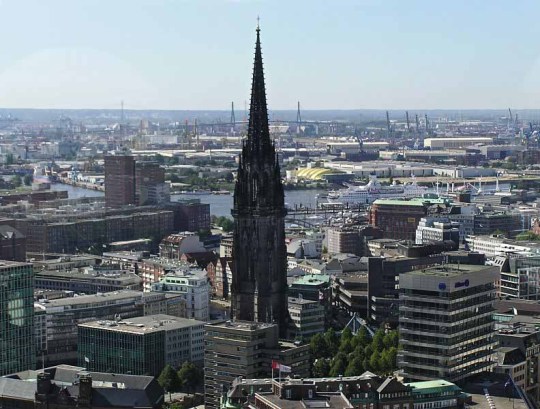
The Gothic-style spired tower stands out like a beacon, it is the second tallest structure in Hamburg.
Photo Link
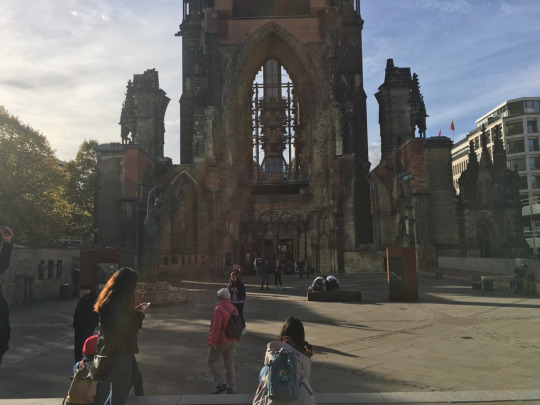
Spire side view of the ruins, the spire-tower, once hollow, the damage to the details noticeable... now contains an elevator and information on the church remnants.

“Founded in 1195, St. Nicholas is one of the oldest churches in Hamburg. It develops from a little chapel to a hall church. During the Great Fire in Hamburg in 1842 it burns down.” (although it was destroyed and rebuilt times before this point).
“The citizens of Hamburg, however, facilitate to rebuild the church in a neo-gothic style. The plans are designed by British architect G. Scott, the construction lasts from 1846 to 1882.”
“In July 1943 Allied airplanes attack the city of Hamburg. During the air raids more than 35,000 people die, 900,000 become homeless, 250,000 houses are destroyed, as was St. Nicholas.”
“After the war, St. Nicholas is not rebuilt. The remains commemorate the victims of the “Fire Storm” over Hamburg and the victims of the German atrocities in Europe.”
Photo Link
Lunch on own:
Züm Spatzle
The front page is a letter to guests expressing how the importance of knowing where one's food comes from. The restaurant has close ties to the source of each ingredient used, everything is listed in the letter. The ingredients of every menu item are listed. The menu is small to keep everything home-made and high quality.
“Our meals are very traditional, home-style cooking. I hope you enjoy this cuisine from my homeland! We always fo our best!”


Spätzle with green pesto and parmesan. Topped with arugula, cherry tomato, and balsamic vinegar.

Maultachen in vegetable broth. (This was my favorite

Cheese Spätzle baked in the oven, with onions (caramelized + chives).
16:00 – 18:00 Group Visit: HafenCity – Sustainability Tour

Mr. Thorsten Gödtel is going to be our guide and the focus of the tour will be on sustainability concepts of HafenCity
70% of the German population lives in cities, this proportion is expected to increase in the future. HafenCity is the largest inner-city development project in Europe. There is an emphasis on making the infrastructure compatible with renewable energy, minimizing resource use and detrimental environmental impact, maximizing green space per urban/industrial area.
Photo Link
Depart to return to hostel to check in 19:00
Meet in lobby to depart for group dinner
19.30 Group Dinner: Loving Hut Vegan Restaurant

An international all-vegan chain in which each location can offer its own menu items, but must remain completely vegan. We had a sesame/ginger soup and a whole bunch of spring rolls. It was quite good, I haven’t been to a bad Loving Hut... there are a great number of other vegan restaurants unique to Hamburg worth checking out as well.
Photo Link
Rest of evening on own.
(went home, went to bed)
MONDAY
Morning Run #1
Went out early in the morning for a run, it was interesting to. see the city as the sun rose. The streets were bustling with morning traffic, the still active harbor was alight with ships coming in and out.
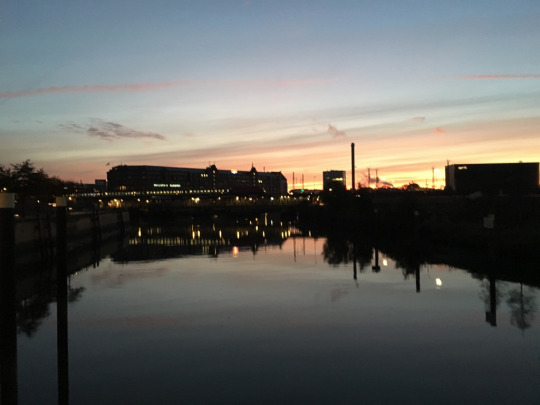
7.30 Breakfast at hostel.
8:40 Depart for a group visit
9:00-10:00 Group Visit: Farmers Cut
We visited a pilot vertical farm, working to bring locally grown greens to the people of Hamburg through dryponic cultivation. The process requires no pesticides and assures fresh, hyperlocal produce to markets and restaurants within the city.

Isabel Mlitor, a co-founder and current CMO of Farmers Cut. She gave us the tour through the Hamburg facility.
“[Indoor vertical farming] captivated me immediately as I was already following the development of next-generation farming in the USA – especially in New York – and knew what an incredibly fascinating topic it is: the link between technology, urbanization, and nutrition. All areas that carry great meaning for all of us.”
Photo Link

A view of the plants growing within the vertical farm .
Photo Link
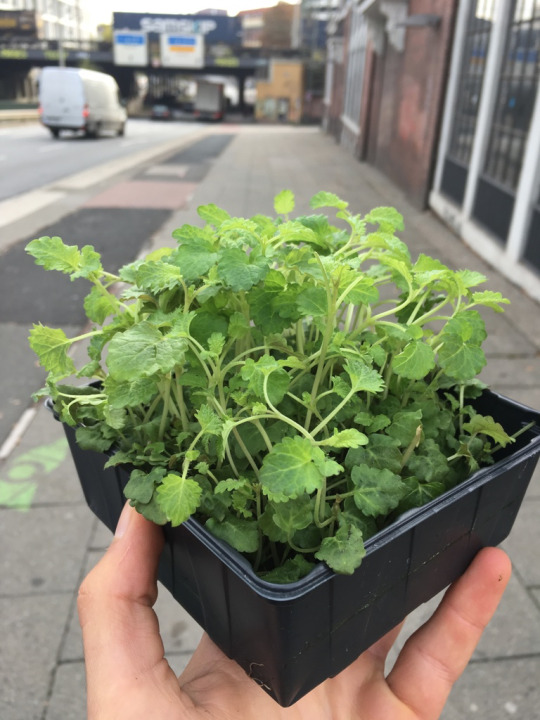
A souvenir, some Lemon Balm fresh from the vertical farm.
Depart for Walking Tour 10:45- 12:45
Alternative Hamburg Tour Starting point: Sternschanze Bahn station
A tour through the Schanze neighborhood... focusing on the role graffiti art and tagging plays in creating the unique environment and giving voice to locals.
Here are some photos from the tour.


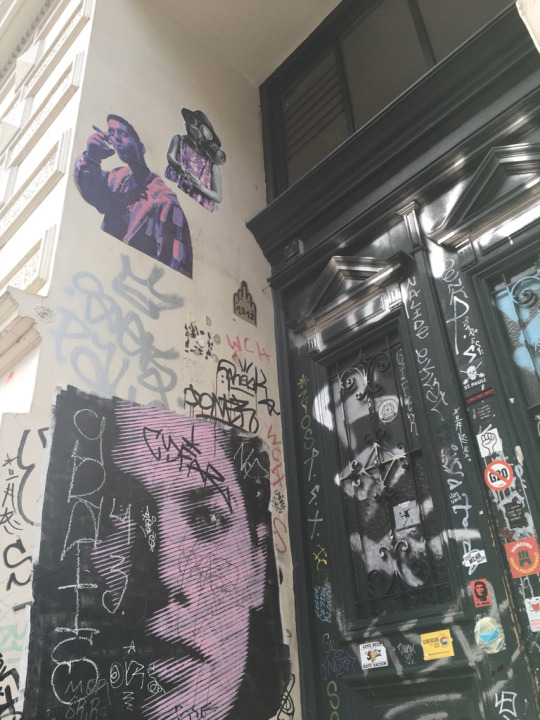


Time on own: Adventure around Sternshanze
A mysterious knick-knack store
I couldn’t find the name of the place anywhere, I don’t know if it was a shop, a museum, I don’t know... I never asked the guy sitting amongst the mess, he was busy reading and smoking .a cigarette (which are then placed into jars and placed throughout the room.

A Google Maps image of the entrance... the interior is below the Elternhaus.

This place was just an amalgamation of all sorts of unusual items... skulls wrapped in copper wire, meat grinders, people’s postcards, CPR dummies, dirt, et. cetera.
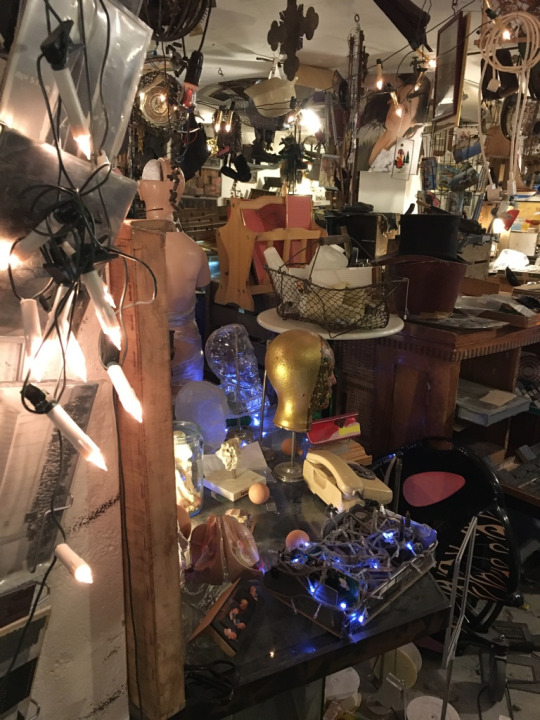
The place is a horribly messy art piece, everything seems to sort of have a place... sort of...
Hot Dog Thrift Store

A collection of curated vintage clothing, the owner seemed quite knowledgeable and passionate about the shop’s collection. The place is a fun visit, everything is quite expensive though...

Hermetic Coffee
“Living and breathing the diversity of coffee, we are very pleased that our café is giving us the opportunity to share with you the full range of coffee flavours.
We serve hand brewed speciality coffee from our own roasts as well as from appreciated roasteries from all over the world.
For you to explore the world of coffee at your home, too, we offer freshly roasted coffee and a wide range of brewing equipment such as scales, drippers, hand mills and much more.
Should you have any questions, feel free to approach us at all times – we are happy to help you.
We are looking forward to your visit.“
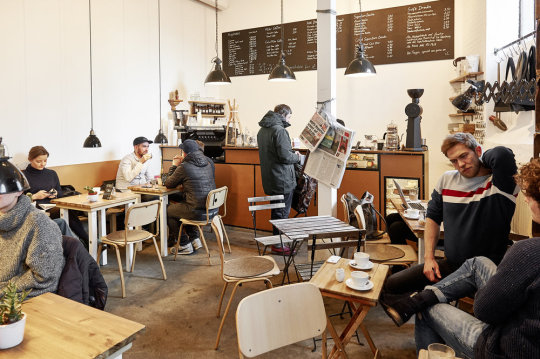
The café interior.
Photo Link

Espresso, the go-to for every café I visit.
18.36 Depart on train for Berlin
20.19 Arrival at Berlin Hauptbahnhof Depart by public transport to hotel
Approx. 21:00 Arrival/check in: B&B Hotel
Rest of evening on own
TUESDAY
Morning Run #2
Got up early once again to get a first look at Berlin as the sun rises. Our hotel is near Tiergarten, a large green strip similar to NY’s Central Park or SF’s Golden Gate Park. It was once the royal hunting grounds, it was turned into a protected public space in the 1700s. Much of the park was clear cut during a coal shortage during WW2. It has gradually been replanted thanks to local donations.

The Victory Column, commemorating the victory in the Prussian-Danish war.

A sunrise along the road that runs through Tiergarten. Morning traffic had began, everyone was starting their Tueday in Berlin.

Soviet War Memorial, commorating soldiers killed in the Battle of Berlin.
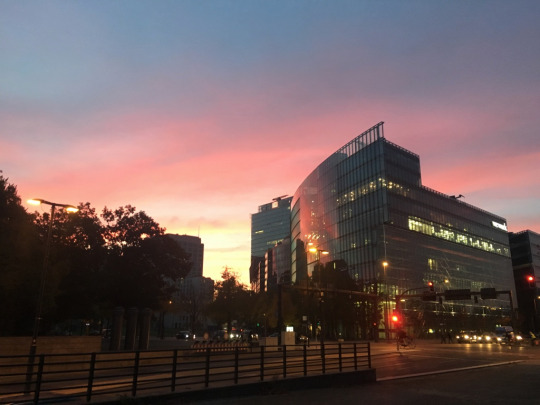
The sunset reflected upon the glass buildings near the hotel we were staying at.
8:30 Meet to depart for group visit by public transportation
9.30- 13.00 Group Lunch + Academic Visit: Das Baumhaus
Project & Space for Sustainability in Berlin Gerichtstraße 23, 13347 Berlin A workshop on sustainability and community engagement And a hands-on workshop – building stuff with tetrapaks.
“A place to meet neighbors and other people who want to make the world a better place in Berlin! The project space is a platform for meetings, events and workshops for a variety of people and organizations. Das Baumhaus is an open socio-cultural project in Wedding. They connect, inspire and empower each other, neighbors, organizations and local changemakers working for transition to sustainability. In the project space, people and projects from a broad variety of backgrounds come together, meet and collaborate.
Das Baumhaus is a self-organized, grassroots initiative grown out of the neighborhood, with Karen & Scott, the project co-founders at the core of the Baumhaus project. Since 2012, more than 300 people have collaboratively developed the project, organized events, meetings, initiated new groups, and in 2016 renovated a storefront space into a pretty unique project space. Organized as a non-profit association, a social business and above all, an open network.”
We discussed the foundational thinking of Das Baumhaus... recognizing the world as a conglomeration of multiple systems within a collective balance. Sustainable development should be looked at from 6 perspectives: Personal, Ecological, Aesthetic, Cultural, Economic, Social. We then pretty much did arts and crafts to make upcycled things for an hour and a half.

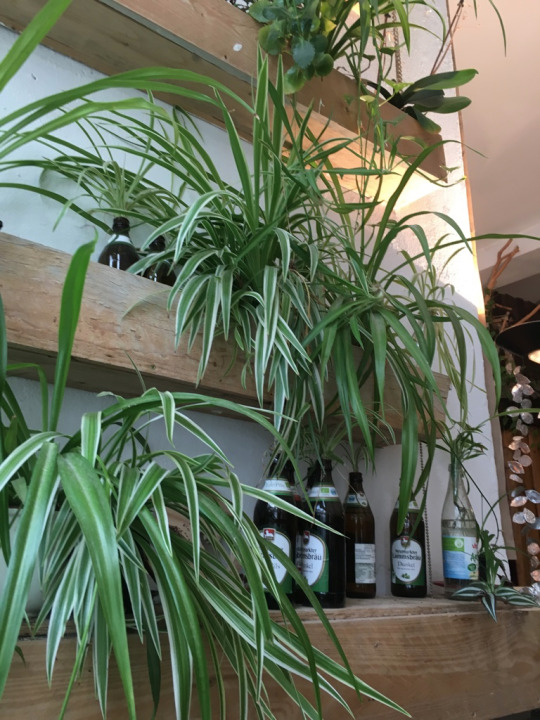
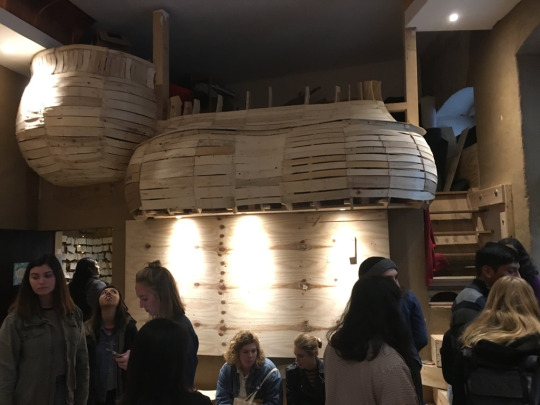
Lunch is served by the Real Junk Food Project, they only use rescued food. (i.e. food that is still good to eat but would have been thrown out without someone using it ASAP)
Time on own
16:00 Meet at Orinienburger Tor U-bahn station
16:15 – 17:45 Cultural Visit: Private Viewing of Boros Collection Inside Bunker Reinhardtstraße 20 10117 Berlin
“The Boros Collection is a private collection of contemporary art. It comprises groups of works by international artists dating from 1990 to the present. Different facets of the collection are on public display in a converted bunker, with 3000 sqm exhibition space. “
1942... Construction of the bunker as an air-raid shelter for the civilian population, built by forced laborers.
1945... Bunker occupied by the Red Army and used for prisoners of war.
1949...Use as a textile warehouse.
1957... Converted into a warehouse for imported tropical fruit from Cuba, managed by a state-owned company “Fruit Vegetables Potatoes”. Known locally as the “banana bunker”.
1990...After German Reunification, the building becomes the property of the federal government.
1992...Techno music and fetish parties mean that the bunker gains a reputation as the hardest club in the world.
1996... Art exhibition Files featuring Olafur Eliasson, Daniel Pflumm, Ugo Rondinone, and others.
2001... Nippon Development Corporation GmbH acquires the bunker.
2003... Christian Boros purchases the bunker to convert it to house his collection.

Photo

He Xiangyu, Untitled (2017)... Bronze cast egg cartons, gold plated.
Photo
Rest of evening on own including dinner
Mogg
“Mogg is housed in an old red brick former Jewish girls school on Berlin’s August Strasse, designed by Alexander beers in 1927. The modernist stark exterior of the school come hospital is belied almost by the colorful art deco tiling in the communal areas. The building's appearance, combined with its long history makes this a cultural must-see in itself.
mogg was added to this eclectic mix in 2012 and quickly established itself as an institute on the Berlin culinary scene. the menu is speckled with home comfort staples such as matza ball soup and new york cheesecake (locally known as the best in town), which sits comfortably aside seasonal salads and of course, the home cured and smoked pastrami- for which the deli is famous.”

The shop interior.
Photo Link

A very serious photo of myself with my Rueben sammo... Pastrami, swiss cheese, Russian dressing, pickled cabbage toasted on a half rye bread with a side of coleslaw and a pickle.
Café Am Neuen See
I had to walk off my Rueben, I met up with some friends at this beer garden within Tiergarten. It’s a pretty spot worthing stopping by for some beer/wine.
The view of the large venue from the dock
Photo Link
Cuore De Vetro
We then journeyed over to this gelato shop that also seems to serve up many other wonderful things (baked goods, charcuterie, drinks). They are open until 11 PM, making it a great place to stop while out with friends.

A view of the interior front. The space is really cool, with a nice seating area out front.
WEDNESDAY
8:15 Meet to depart for group visit on public transport
9:00- 10:30 Group Visit: The Little Sun Project
“The Little Sun Project is a Berlin-based socially and environmentally conscious initiative that was founded by artist Olafur Eliasson and engineer Frederik Ottesen. Together, Eliasson and Ottesen designed a solar lamp that is sold to entrepreneurs in off-grid communities to work towards creating local businesses while also providing a source of sustainable and reliable light. “

Inside the Little Sun office.
Depart on foot for visit 11:00- 12:00
Group Visit: Inken Behrmann, an activist from Ende Gelände Volkspark Friedrichshain We will have an informal talk about the work for ending the coal industry in Germany.
“Ende Gelaende is a broad alliance of people from the anti-nuclear and anti-coal movements, the Rhineland and Lausitz climate camps and the Hambacher Forest anti-coal campaign. They are from grassroots climate action groups, large environmental organizations, left political groups and many other campaigns, groups, and networks.
Ende Gelaende all share the belief that to stop climate change we need to take action ourselves, using civil disobedience as a powerful signal for real action to put our climate before profit.“
Time on own including lunch
Engelberg
“A visit at Engelberg is a great way to experience a proper German breakfast, which traditionally consists of sourdough bread and rolls served with of loads of charcuterie, cheeses, and spreads. The secret to Engelberg is simple: The crew sources the best goods from all over the country and serves it on a beautiful sidewalk patio.“
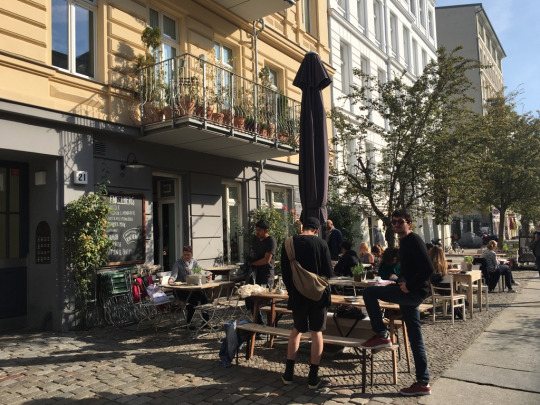
The sidewalk patio, it was a wonderful day and a wonderful visit. Everyones food was delicious, this place is most definitely worth the visit if nearby.

Farthest left (somewhat out of view): eggs with smoked ham, German rye, fresh tomato. Then we have gulasch with bread, spaetzle with ham, a boiled sausage with a pretzel and mustard, gulasch with spaetzle, salads. They also have a wonderful selection of drinks.
14:45 Meet at giant TV tower in Alexanderplatz for bike tour
15:00- 18:00 Group Activity: Fat Tire Bike Tour
Our guide brought us to a number of different historical landmarks throughout Berlin. It was a better time than I had expected, it was a nice day for a bike ride.
Humboldt University
One of the world’s most influential universities in the 19th and 20th century, linked to major breakthroughs in physics and other disciplines by its professors... such as Albert Einstein. It was the site of one of Nazi Germany’s largest book burnings, the Book Burning Memorial is now in the center of the pavilion.

Berlin Wall
Still standing portion, most of which was torn down in 1989.
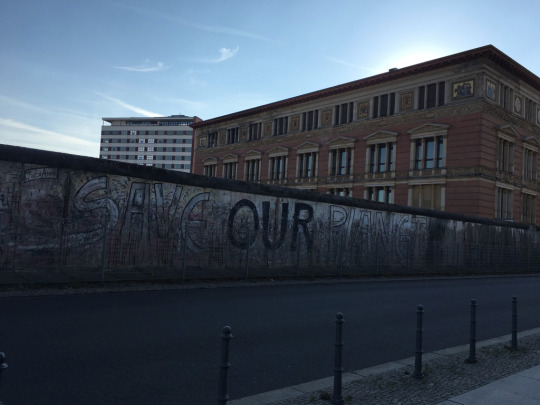
Memorial to the Murdered Jews of Europe
There are multiple interpretations to the memorial, as nothing explicitly suggests its purpose. There are 2,711 concrete slabs of different heights, laid upon the ground of different elevation. Walking further into the monument, one is surrounded by the granite slabs.
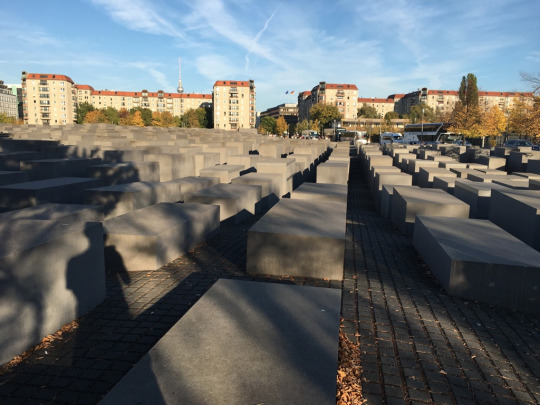
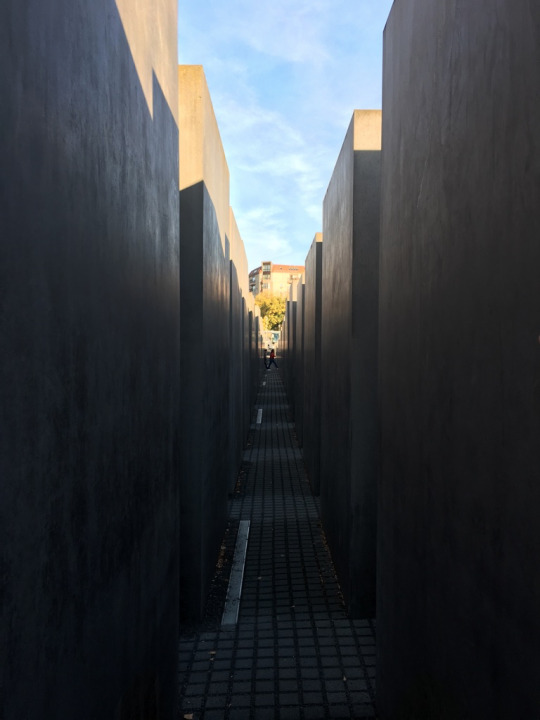
Brandenburg Gate

Altes Museum

Berlin Cathedral
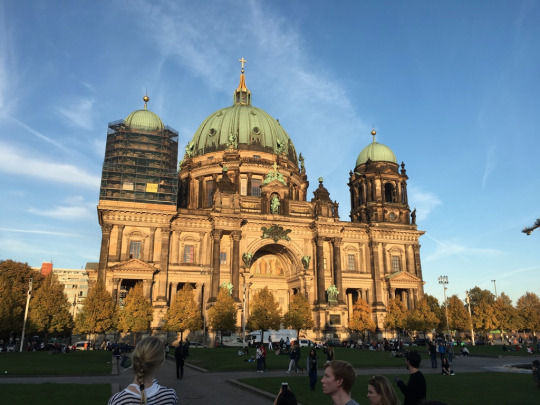
18:15 Group Dinner Good Bank
“We are the first vertical-farm-to-table-restaurant in the world.
We grow our own vegetables and salads – right before your eyes and for your culinary pleasure. In doing this, we transform unused urban areas into productive farms from which produce can be harvested and used fresh.
We avoid using any kinds of pesticides or genetically modified seeds and protect the environment by removing the need for long cold chains, transportation and packaging waste.
It doesn’t get fresher than this – and it’s a difference you can taste. Our salad leaves also contain more nutrients than those farmed using conventional agricultural methods.
Our vision is to produce all our food self-sufficiently – starting with the three self-grown lettuce and vegetable varieties we currently offer. Others are set to follow.
We hope to play a role in the development and promotion of an increased awareness of sustainability.”
This visit was a lot of fun and the food and drink were simple and delicious. We were served a pumpkin soup, a combination of different salads and bowls, and desert... along with wine, beer, or non-alcoholic tonics and juices. We were given a jar of local honey as a souvenir.
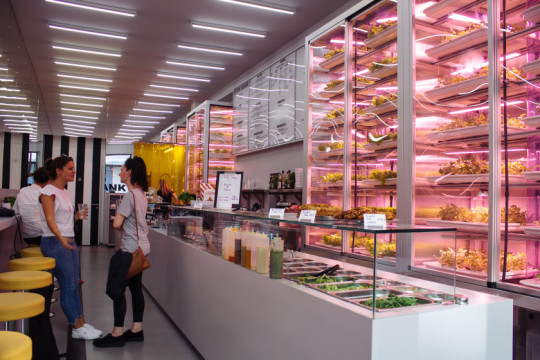
Rest of evening on own
Klunkerkranich
“It doesn't get much more Berlin than Klunkerkranich, a makeshift bar on the top floor of an abandoned parking garage in the middle of Neukölln. Equipped with one of the best views over the city and stocked with plenty off cold drinks and savory snacks, this place is one of the ultimate late night bars in Berlin. Stick around for its famous after-hour parties.”
This place was really cool and is definitely worth the visit when in Berlin, take the elevator inside the mall up to the fifth floor... follow the signs to this unusual oasis amongst the city.

Photo
THURSDAY
8:15 Meet in the lobby to depart for the group visit
9.00 – 11.30 Group Visit Agora Energiewende
“In 2012, the European Climate Foundation and the Mercator Foundation founded Agora Energiewende to tackle the challenges posed by the energy transition. Its official mandate is to develop academically rigorous and politically feasible pathways for transforming energy systems toward clean energy in Germany and across the globe. Because its core funding comes from philanthropic organizations, Agora is fully autonomous, operating independently of business interests and political pressures. Within the framework of some international projects, Agora receives public funds in the form of grants.“
11:30 Lunch & time on own
Azzam Restaurant
“Famous for extraordinarily tasty fatteh and hummus, the Palestinian owners of Azzam have created a true melting pot for hungry diners of all stripes to experience the cultural and culinary diversity of Neukölln.”
One of the many places brought up through immigration to Berlin. The space is a meeting place for locals and visitors alike, the place was packed... and the kitchen was booming as fresh ingredients were thrown together and tossed out on large plates of deliciousness.
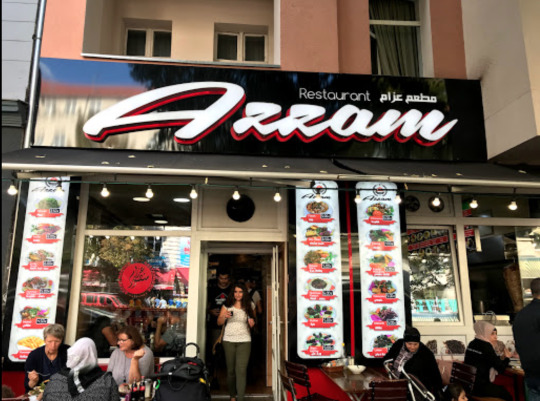
Gamäldegalerie
“The Gemäldegalerie boasts one of the world’s most important collections of European painting ranging from the 13th to 18th century. Masterpieces from all epochs in the history of art are on permanent display here, including paintings by Jan van Eyck, Pieter Bruegel, Albrecht Dürer, Raphael, Titian, Caravaggio, Peter Paul Rubens, Rembrandt, and Jan Vermeer van Delft. The gallery is especially proud of its strong collection of German and Italian painting from the 13th to 16th century and painting from the Low Countries dating from the 15th to 17th century.“

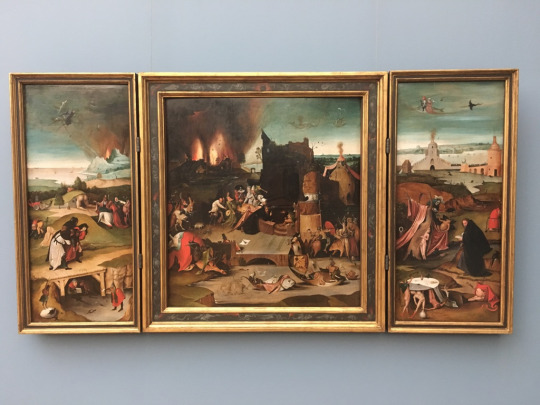
Hieronymus Bosch ... Triptych of the Temptation of St. Anthony (1501)
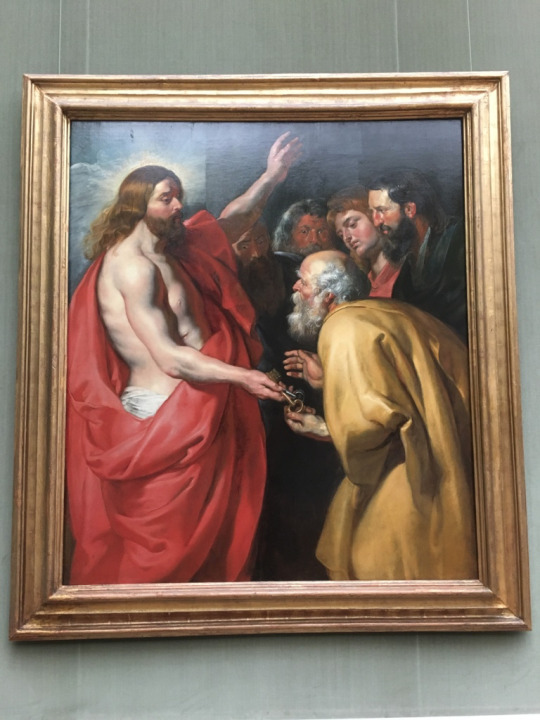
Peter Paul Rubens ... Christ Giving the Keys to St. Peter (1614)

Rembrandt ... Self-Portrait with Velvet Beret (1634)
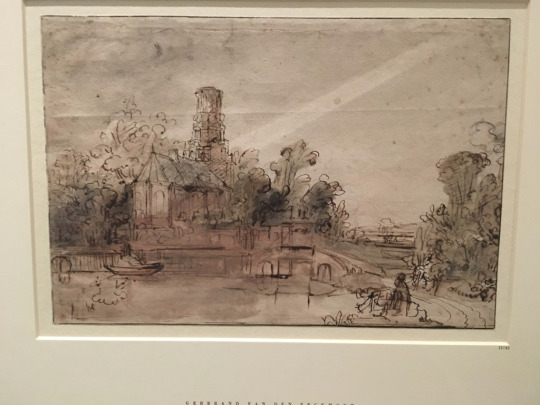
One of Rembrandt’s etching, there was an entire exhibition on his own and his students etching. It is difficult to discern between his own and his student’s work.

Caravaggio ... Amor Vincit Omnia (Love Conquers All) (1602)
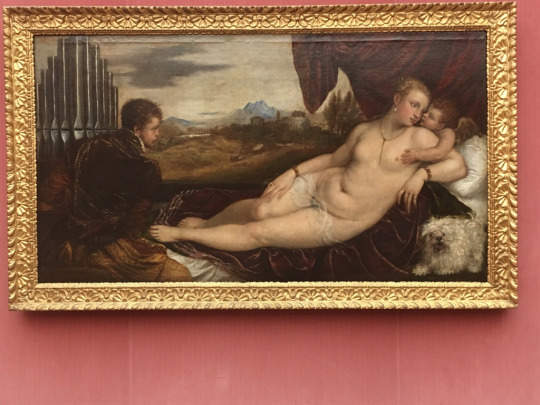
Titian ... Venus and Cupid (1549)
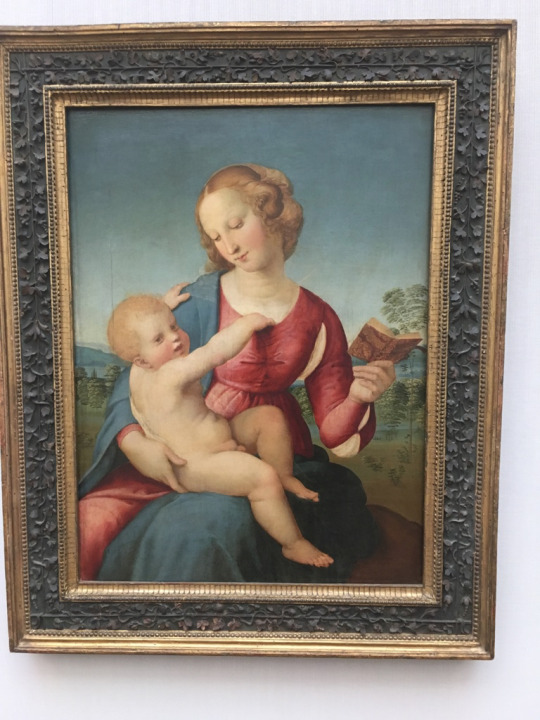
Raphael ... Madonna Colonna (1508)

Sandro Botticelli ... Portrait of a Young Woman (1480s)
18:30 Group Dinner
FRIDAY
9.15 Depart for the academic visit by public transport
10:00 – 11:30 Group Visit: UfaFabrik: International Center for Community and Ecology Viktoriastr.
“Internationally, the UfaFabrik enjoys considerable recognition as a leading demonstration in the areas of culture, community, and ecology. The UfaFabrik Berlin is a living example of the possibilities that exist for creating attractive, socially and ecologically just ways of living in a metropolis.
We will discuss sustainable energy at the center and how community involvement has been crucial to the development of UfaFabrik Berlin. A site which had been a wasteland for over half a century. Along with friends, fans, activists, and neighbors, the group cleared away rubbish, built transportable organic vegetable plots and reaped the first fruits of their labor.”

From the green roof of one of the buildings, much of which contains solar panels. The energy is sold to the local community when there is a surplus and bought back when there is a shortage.
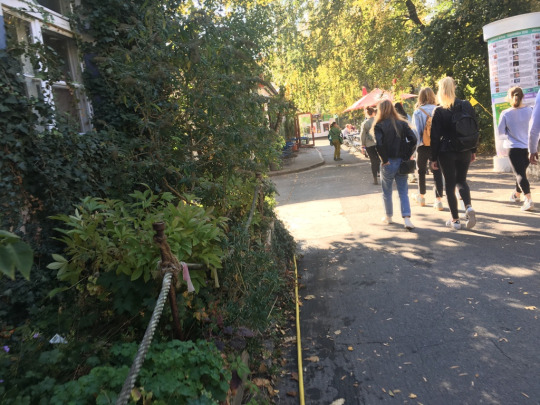
Walking along the path of the community. The buildings originally made as a film factory now house all sorts of things... a dojo, music studios, schools, a fire-oven bakery, and more.
Depart for hotel by public transport
14.00 Pick up luggage at hotel and depart for main train station by public transport
15.06 Depart on train (EC 174) for Hamburg
17.11 Arrive in Hamburg and switch to train to Copenhagen
17.28 Depart Hamburg for Copenhagen (EC39)
The sunset seen through the train window.

22.26 Arrive in Copenhagen
I arrived to the energetic bustle of culture night in Copenhagen, its very unfortunate that we didn’t plan around culture night. It would have been worth it to come home early in order to be a part of this special night.
I was happy to be back in Copenhagen, I went home to make some oatmeal and went to bed.
0 notes
Text
Week 5, 6, 7: Cliffs, Mushrooms, Baking, and Friends
The weekend of Week 5 began with an adventure south to Møns Klint of the island town Borre. The chalk cliffs (highest in DK) stretch across 6 km of the Baltic seashore. The cliff area also has wonderful woodlands full of wildlife and plants (the chalky soil makes the site ideal for many rare plants, primarily orchids that blossom in the early summer).

Friends from my core course and I rented a car from Copenhagen Airport as Møns is quite a ways south. Public transport is possible but would take a very long time (most of the day would be spent just getting to the destination). Going by car from the airport straight to the cliffs takes around an hour and a half and isn’t too expensive (rent, gas, and parking totaled around $40).

On the way to the cliffs, we stopped at the Faxe Limestone quarry. According to CPH Coast and Countryside, the fossils of ancient aquatic animals from millions of years ago who called the landscape (once seabed) home can still be found encased within the limestone. The nearby Geomuseum Faxe holds fossil hunts and is also open to examining anything you find in the quarry while excavating on your own.
I really loved the way the landscape looked... it was almost like being on another planet with the chalk-white earth and glowing turquoise lakes.

The forests around Møns Kilnt (which is off to the right). Dancing trees and living forest floor are illuminated by the light rays that break through the canopy from above.
This area is worth visiting in itself.

View of the cliffs, the shore, and the Baltic Sea. In some areas, the cliffs are a sheer 120 meters to the sea-level.

Sea-level view of the cliffs. The chalk is from the remaining shells of coccolithophores, microscopic creatures that lived on the seabed 70 million years ago. Glaciers pushed the terrain upwards and left the cliffs when the last ice age ended. The site holds a great number of ancient fossils.

My Environmental Philosophy class took a trip to the Hvidovre Cooperative Windmill. Erected thanks in part to investments from the local community and business of the greater area. The energy produced is enough to supply approx. 5,000 homes for a year.
I visited two bakeries these past two weeks. I also visited a DIS Host Family’s home for a baking workshop and pizza night.

JUNO THE BAKERY
I can’t find much on the place that isn’t in Danish. Google Chrome’s translated English doesn’t help much. Check out their Instagram as they consistently post and update their stories on current happenings at the bakery. If you enjoy bread, pastries, tarts, and other such things... don’t miss out on this place. It’s a quick walk off the Nordhavn train station (B and E lines).

Rye Bread, my favorite, filled with all sorts of whole grains and seeds. It was faintly sweet in some parts, was a wonderful thing to pack in my lunches.

HART BAGERI
A brand new bakery (opened 8/30/18), from Richard Hart... sourdough master, and master of many other baking and food-related things as well probably. He has brought together a whole group of highly talented bakers to bring Copenhagen’s bakery scene (as world-class as it is) to a whole new level. A lot of important info about the bakery and Richard Hart can be found here.

Country Sourdough (SF Tartine style) and Classic Rye Bread. There were a number of sweet things I had as well (ate them immediately, couldn’t wait until home), the menu is likely to consistently shift... follow the bakery and/or Richard for updates on what is being served.

This is opening day, it was high functioning chaos. Everyone, customers and staff, were in very high spirits to be sharing these first moments of the shop’s opening.
One of the host families puts on a baking class and pizza night twice a year for the different semesters. The father is a skilled home baker who has been baking his own bread every day for years. He taught us how he makes “daily bread” and rye bread.

Part of the outdoor pizza making setup. My first post mentions how I’d like to improve my pizza dough, the dough here is something I’d shoot for.

The woodfire oven. A future goal I have for myself is to make my own oven at my home.

My pizza. (Look at the crust, that is good pizza dough)

Fresh “daily” bread. This bread is quick and relatively simple to make. A perfect and simple accompaniment to everyday meals.

For dessert, we had gammeldags æblekage... AKA the best applesauce I’ve had with whip cream and crunchy cinnamon sugar.
I’ve been wandering through the forests near my home in Virum. One of which is a National Forest called Bøndernes Hegn. Its dense, rich forest is filled with hiking and mountain biking trails. I never took a photo of the landscape (think green, full of trees, moss, other living things, you know)... but I did take photos of a few of the many mushrooms I’ve come across on my adventures.

Fly amanita (aminata muscaria). Considered poisonous (and psychoactive). The mushroom is consumed in various parts of the world for its hallucinogenic properties... it can also be prepared a certain way to remove toxicity, making it edible (possibly).

A stinkhorn (that fell over). (Phallus vulgarus) This mushroom is known for its strong odor, which it uses to attract insects that will then help spread its spores through the forest. The Dans call this mushroom præstens pik (use google translate for English).

I found this geocache under the tree stump I had my lunch on. I took a cool little bottle opener and left a US one dollar bill. There was a little book for people to sign and I am pretty sure the first signature was from 2007.
I was inspired to start making my own bread after going to Hart Bageri and the Host Family baking lesson/pizza night. The friday night before long study tour, I held a small dinner with a few friends. I got to try my hand at making bread (I also made rye bread, which came out really nicely)

Sourdough starter. Just rye flour and whole wheat flour with water. With enough feedings (white flour and water), the natural yeast in the flour will begin to bloom. This can be used in place of the yeast you buy from the grocery.

My first (successful, not talking about the failures) little loaves of bread. I’ve got a lot to work on but I was happy with this outcome. The ingredients are just white flour, sourdough starter, water, salt.

Everyone around the dinner table.

Minestrone soup in the big pot. A pan full of kale, mushrooms, roasted almond, roasted pine nuts, parmesan. A smaller pan with homemade lemon ricotta (served with the kale). In the distance is a mix of my friend’s bread and my own. Not pictured is butternut squash cooked into a stew.
0 notes
Text
Core Course Week
MONDAY
9.00-9.05
Welcome to Core Course Week
The day is dedicated to the urban environment and the sustainability challenges and solutions in Copenhagen.
9.05-10.30
Accelerating Urban Sustainability with Cycling Morten Kabell, COO Copenhagenize and a former Mayor of Copenhagen
---
A presentation on the history of Copenhagen’s transportation infrastructure and its influences on the city’s people and productivity. We are shown the power of public transportation, bicycle, and pedestrian-focused infrastructure in improving the health and sustainability of a city. Cities need to focus on how well people are transported, not merely how well cars are. Through a well-planned human-centered approach to infrastructure planning, the city better caters to the people that live in it. Spaces are opened up as parks, traffic is reduced, people can relax more...

---
10.30 - 12.00
Copenhagen Sustainability Treasure Hunt
---
We were sent to Ørstedparken and Kogens Have to compare and contrast the two parks green spaces. Similar to my Urban Ecology course, we considered both spaces from a habitat perspective, a human-centered perspective, and a biogeochemical cycle perspective.
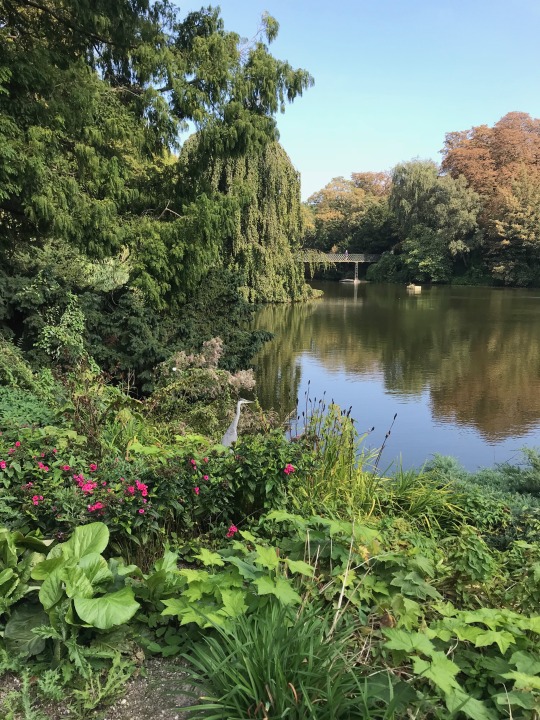
Ørsedparken, a view of the garden, a crane, the lake, and the bridge. I’ve posted about this place before when I wrote about the Urban Ecology trip.
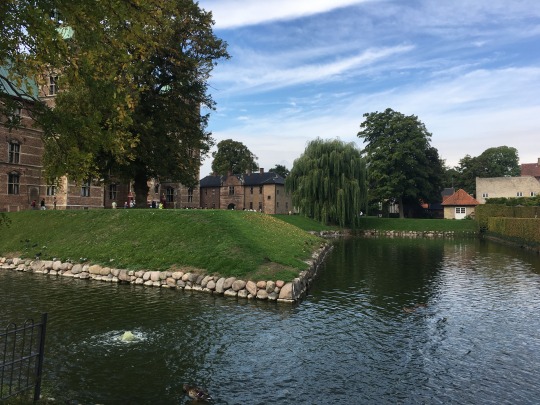
Kongens Have, view of the mote, a lawn, the trees, and the castle.
---
12.00- 13.00
Break and Lunch on your own in DIS + preparation of the stories (Blog)
---
We were to make a blog post of our park observations on a site shared by all three Sustainable Devopment Core Course sections.
Here is the link to the blog site.
---
13.00- 13.30
Short discussion of the highlights of the Copenhagen Sustainability Treasure Hunt
13.30- 14.00
Presentation by Anders Jensen Turning the busiest street upside-down
---
A presentation on turning one of the most car-traveled streets into an urban river, as it is a site that commonly floods during heavy rain (the area was once a natural river, they reformed it into a road). The route can be maintained by placing the road in an underground network This maintains the important vehicle-route while better providing green-space on ground level.
---
14.00- 14.15
Short Break
14.15- 15.00
Rewriting your Copenhagen stories
In your group from the treasure hunt this morning. Rewrite the story but try to imagine how the place you visited could be radically transformed to be as sustainable as possible.
---
Here is a link to our revisited blog post.
---
15.00- 15.15
Day 1 Wrap-Up
TUESDAY
9.00-9.05
Introduction to the day
9.05-10.00
Finding Opportunities with Food Sustainability
Kasper Kastoft Nielsen, Founder of YourLocal
Kasper has created a successful business aiming at reducing food waste by selling food, that otherwise would be disposed of, at a discounted price.
---

(Photo from YourLocal’s website)
The app, YourLocal, serves as a marketplace where restaurants, bakeries, markets, and grocery stores can sell their leftovers to customers at a reduced price. With many thousands of regular users within the local area... and many more joining every month, the app may be one solution of many that we can develop to reduce food waste ...
A link to their website.
----
10.00-11.00
Sustainability in the food supply chain
Find your group and design your questions for the interview with the food sustainability innovators across Copenhagen.
---
Each group was assigned different food sustainability innovators... The individuals ranged from a local zero-waste food markets owner to the chef of a cutting-edge restaurant to an individual farming high-quality oyster mushrooms with used coffee grounds. We interviewed Søren, who is involved in Bugging Denmark, a cricket-farm/food company working to push the integration of crickets and other insects into the common western diet.
---
11.00-11.30
Traveling time to Visit
---

We met Søren at Dare2 Mansion, a former car workshop turned quirky co-working space for local business startups.
---
11.30-12.30
Interviews with local leaders of food sustainability.
13.00-13.30
Sandwiches + coffee provided by DIS
13.30-14.00
Write a short blog story about the visit
---
Here is the link to our blog post.
---
14.00-14.15
Break from the old groups and join a new group
14.15-15.30
Food & Sustainability Matrix Activity
You should be with a new group where you will share your visit with other students who have not been to your visit.
15.30-16.00
Day Two Wrap Up
16:00-17:30
Time on own before dinner
17.30 – 19.30
Social Dinner: The Neighborhood
---
This was a lot of fun. Our class filled the entire upstairs room. I enjoyed talking with my table (some students and our professor) about all sorts of fun things... like politics and what not. The pizza was unusual but quite good.
After dinner, a large group of us bombarded a cheesecake shop moments before they were going to close. I saw the initial fear the only employee’s face as she prepared to serve us two full cheesecakes worth of slices. It went well though. The place is called Bertel’s Salon, they can handle inconsistent arrivals of 15 people 15 minutes before closing.
Many went home after cheesecake, while a few of us went to Bastard Cafe to play some sort of game similar to Pictionary. This spot is awesome, filled with locals drinking beer, eating food, and playing one of the many board games available. Most are free to play, just grab whichever you want right off the shelf. I definitely hope to find myself in this place sometime in the future.
---
WEDNESDAY
All Day Off – Explore Copenhagen and Prepare for Short Tour
---
Started the very rainy Wednesday by meeting up with two of my friends at the wonderful Slurp Ramen Joint. I grabbed the Vegetarian Ramen.
We then walked over to St. Peters Bakery for Wednesday Cinnamon Rolls, supposedly best in Copenhagen. I will be going to many more bakeries in the future (when the days shorten, become grey, wet, and cold). I’d like to do a rundown on all of them at the end of the semester.
After ramen and cinnamon rolls (an unusual combo)... we walked over to the National Museum of Denmark. For my second visit, I made sure to go through every part of the museum this time... it was quite a lot.
Here are two exhibits I thought to be pretty cool.
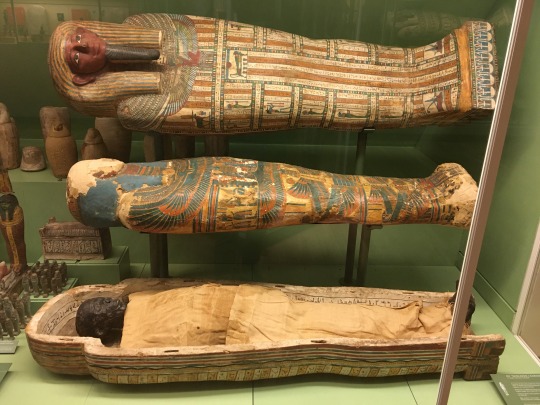
A “LEADER OF THE CHORUS IN KARNAK”
The priestess Di-Mut-shep-n-ankh died at the age of 35. She was wrapped in 15 garments, which had been re-used as mummy bandages
The mummy was found in the so-called cartonnage of painted linen, glued together. Sun gods wrap their wings around the woman. C 700 BC.
The wooden coffin belonged to the pried of Amun Ankh-f-n-Khonsu.
The mummy in the cartonnage - and the wooden coffin - both come from the mass bural of the priests of Month under Deir el-Bahn-temple in Luxor.

THE SAMURAI’S OUTFIT
In the Edo Period, the Samurai warriors were the ruling class in Japan. During this long period of peace, many of them functioned as official, but they still regarded the sword as their most valuable possession. Like the other parts of the Samurai’s military outfit, the sword was produced by skilled craftsmen with an appreciation of quality and artistic design. All the objects on show are from the Edo Period (1603-1867).
---
THURSDAY
7.45
Meet at DGI Byen
Remember to bring your passports!
Depart for group visit in Lund
9.30- 12.30
Group visit: St. Hansgården
---
An organization founded upon and operated under the practice and principles of Permaculture. They hold education courses, an after-school program, and community events aimed to better the community’s children, visitors, and the employees. There is a greater mindfulness in the approach to everything that goes into an activity or project... everything should have three different uses or it��s absolutely necessary despite its single purpose. Sustaining the organization’s land, completing building projects... responsibilities that are necessary and practical to keep St. Hansgården running are very often given to the children. The faculty they didn’t know they had is revealed to them... they tend to the farm animals, manage the gardens, harvest honey, cook, help with building projects, and more.

In this room, they are extracting honey from their beehives. The bins to the left are used to scrape the caps off of the comb, the bucket in the distance to the left is full of honey, the chrome barrel is a centrifuge that spins out the honey... it was still dripping a bit, which is collected in the small white bucket beneath.

With each building project, the planning is completely driven by what they basic goal was, what they need from the project. They planned a space to teach children to cook traditional Swedish / Nordic dishes on an open flame. The gardens are nearby, there is ample seating around the campfire, a nicely sized work table/bin is to the left.

The compost bins. Food is eaten, the waste is composted and turned to soil, the soil is used to make food, the food is eaten... children are able to see the full cycle of their food.

The Animal House
“This unique house was mainly built of timber, clay, and straw. One part of the house has a stable for sheep, goats, cats, and rabits. The other part is a greenhouse. Here you can sit by the fire with your friends. Or be with your rabbits or with the cats of the house.”
We were told one of the children who helped build this house came back (in her 30s) to say that she had placed her necklace within the clay wall when it was near completion.
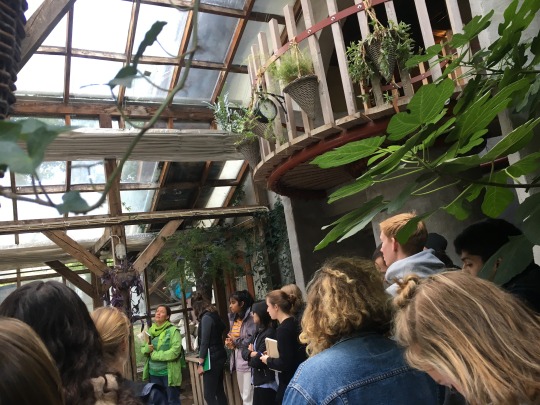
The Barn Greenhouse
Nitrogen from the stables is cycled through to the greenhouse soil in place of using man-made nitrogen sources. In creating the building, all chords, pipes and structural aspects most often hidden were to be exposed to show the children what goes into operating the house.

The Field Classroom
Each classroom is to have a rain shelter nearby and a fireplace.
The shelter has slabs of wood filled with holes to provide environments for solitary bees and the sort.
---
12.30- 13.00
Depart group visit for Lund cathedral
13.00- 13.45
Lunch on own in Lund
---
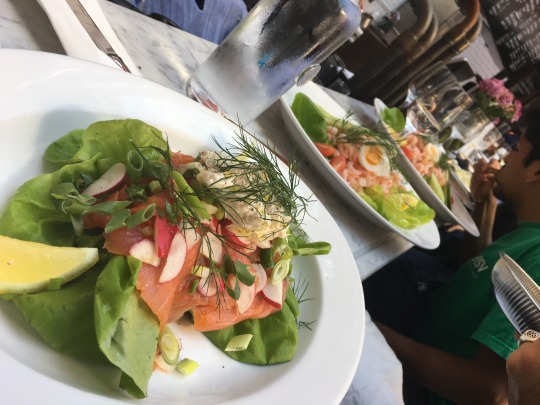
Lox with creme cheese, butter lettuce, radish, green onion, dill, lemon.. on buttered rye bread. The two in the distance is the shrimp salad with similar fixings... had tomatoes and a boiled egg. The place is called Malmstens Fisk and Kōk if you ever find yourself in Lund.
---
13.45- 14.00
Group Visit: Lund Cathedral
---

The Apse and Altar of Lund Cathedral
---
14.00
Meet at Lund Cathedral, depart for Hostel in central Malmö.
14.30
Arrive/check-in:
STF Malmö City Vandrarhem
Time on own
18.30
Meet in the lobby to walk to group dinner
19.00
Group Dinner: Bord13
---
Dear lord this was quite an experience,
The food was really good, the natural wine was wonderful. The fun part was the hour we would have in between the each of the small “gastronomic” dishes... If I can remember, we had: (1) seared arctic char with roasted buckwheat and wood sorrel in a smoky fish broth (2) a sort of mushroom dish with varied greens and a rich broth turned into a foam (I don’t understand the whole foam thing, I couldn’t remember much of this dish). (3) Pork belly in a sauce with a garlic creme, sauerkraut that did not taste of vinegar but of salt, some sort of leafy green... (4) Cucumber ice creme with caramel and a slightly sweet meringue with dill.
Most of what we did in between the four dishes was hilarious to us for some reason... nothing would be funny in writing. I had a good time though
---
Rest of evening on own
FRIDAY
8.00
Breakfast at hostel
---
The breakfast spread was so good... A wonderful spread of fresh fruit, cheese, baked goods, vegetables, yogurt, milk, cereal, coffee, tea, and more. A wonderful start to the day.

---
9.00
Depart hostel for group visit by bus
9.30- 11.30
Group visit and bus tour: Sysav
South Scania Waste Company
---
We began with a presentation on waste production and management within Sweden and the surrounding Nordic countries. Our guide acknowledged that these countries are leaders of recycling or reclaiming their waste but stressed that the problem is now overconsumption. Affluent nations around the world may have a great landfill to recycling ratio... but the ever-increasing magnitude at which consumer waste is coming in negates the progress. The future needs to move toward circular economies among other things to help minimize unnecessary waste.
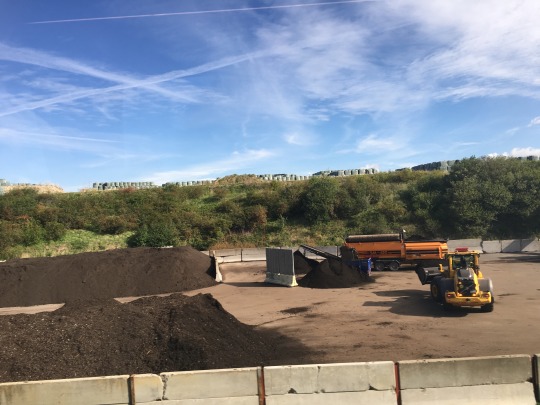
Compost from garden waste, packages of imported combustible waste off in the distance.

Processing of combustable waste.

Imported combustible waste from other European Countries... SYSAV makes money off of the import, and can then sell the energy produced.
youtube
Combustible waste up in the combustion tower. Quite interesting, quite smelly... overwhelming actually, I won’t forget it.
---
11:30- 14.00
Lunch on own in the area around Lille Torg.
---
Grabbed a salad at Holy Greens with friends. It was super fresh and super quick.
---
14:00
Meet bus and depart for Green Roof
14.00 – 15.45
Group visit:
Augustenborg Green Roof Institute
---
We toured the green roofs, discussed the benefits and challenges of retrofitting such things into existing infrastructure... The specific goals of this site. We then traveled along the nearby neighborhood to see the irrigation system for rain runoff.

Lightweight green roof, a very small amount of soil is placed upon the roof... only plants that can survive on the dry surface (low water retention).

The water to the left is drained from the nearby apartment’s laundry machines. The water is purified through the vegetation and eventually flows into the artificial pond to the right. The pond also serves as an overflow pool to help manage floods.
---
15:45
Depart for Western Harbour
15:45 – 17:30
Group visit:
Western Harbor Tour
“The Western Harbor has transformed from being an industrial park into becoming an area for knowledge and sustainable living. Since the closing of Kockums machine halls and cranes have been making way for parks, swimming areas, schools, and living accommodations. The aim is for the district to be an internationally leading example of the environmental adaptation of a densely built urban environment. It will also be a driving force in Malmö's development towards environmental sustainability. “
---
This area was quite beautiful and well made. The issue is that it is one of the highest income neighborhoods in Malmö, the model is not feasible without significant funds from residents.
---
17:30
Depart group visit for hostel near Söderån National Park.
18.45
Arrive at hostel, unpack, get situated.
---

Our cabin/hostel off in the distance.
---
19:15
Meet to walk to group dinner
19.30
Group Dinner: Skäralids Restaurang
Rest of evening on own
---
After a wonderful dinner, we all went back to the hostel/cabin we were staying in for the night. As my friend and I prepared the snøbrod dough I made with our professor a few others got a fire started. We spent the rest of the night with snøbrod (with butter, honey, and jam), smores, and scary stories.
---
SATURDAY
8.40
Breakfast at hostel
---
This breakfast was just as amazing as the other, had a great time.
---
9.45
Depart by bus for the nature hike.
10.00- 13.30
Group visit and hike: Söderåsen National Park
A hike through and discussion of the terrain and landscape’s history, sustainability initiatives, and park management.
---
It was a wonderful little hike. The forest was full of green, of moving things, it was full of life. Everything sparkled from the unusual intermittent blasts of rain and sunshine. As we walked, some of us went on a mini foraging adventure, learning about different types of mushrooms and edible plants.

View of the lake at the park-base, where we began our hike.
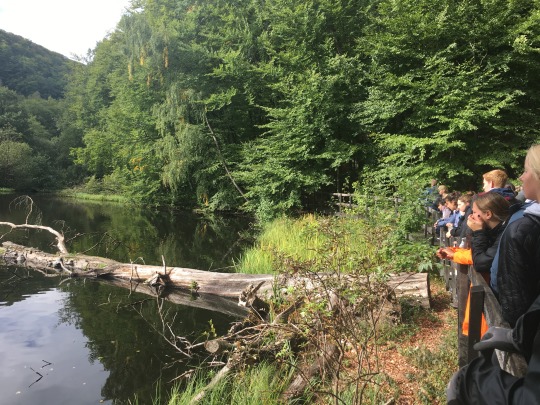
The class looking over the lake as our guide speaks.
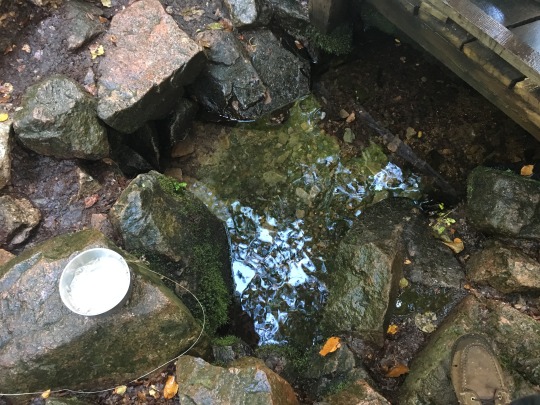
A spring with clean drinking water, to the left is a tin bowl to scoop yourself up some.
---
13.30
Depart for group activity Your crossing back to Denmark will include a ferry ride.
---
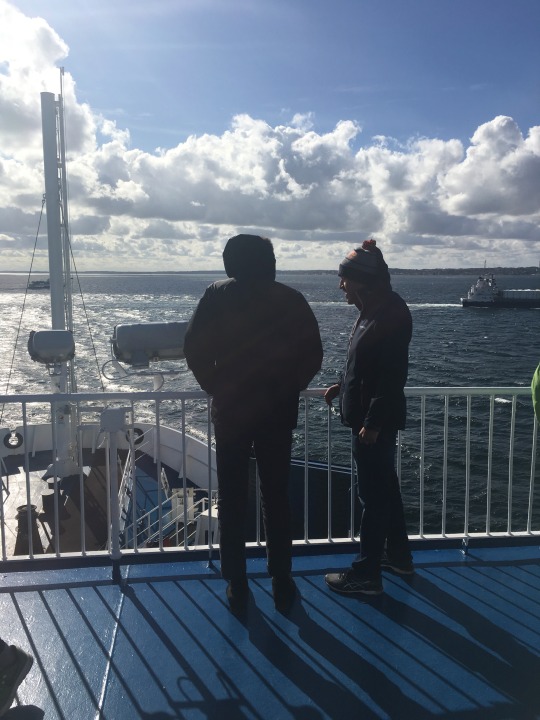
A short, very windy voyage back to Denmark.

Coming to shore, a view of Kronborg Castle... which inspired Shakespear’s Elsinore in Hamlet.
---
15.30- 17.00
Group Activity: Frydenlund Frugtplantage
Introduction to apple varieties and history, then apple picking.
---
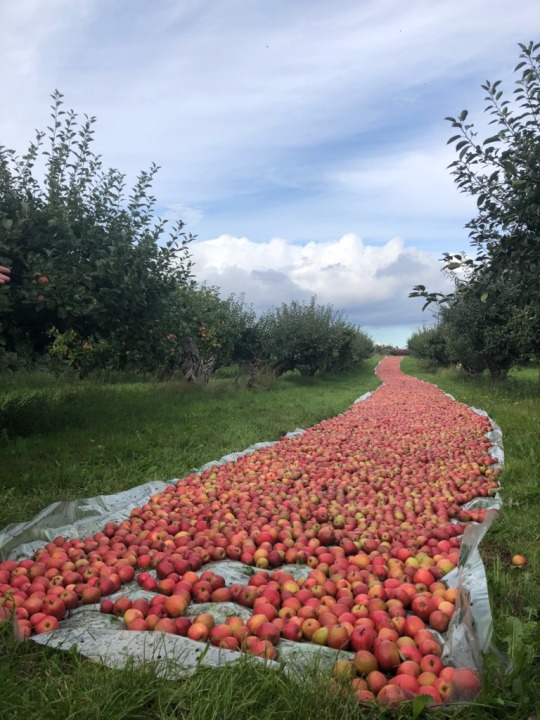
Everyone exhausted, having a stroll through an apple orchard was a nice conclusion to the trip. I got a whole bunch of apples and baked an apple cake with my host family the next day.
---
17.00
Depart group activity and return to Copenhagen
FIN.
0 notes
Text
Weeks 2 - 3, I’ve already done so much! and I (somewhat) remembered to take photos!!
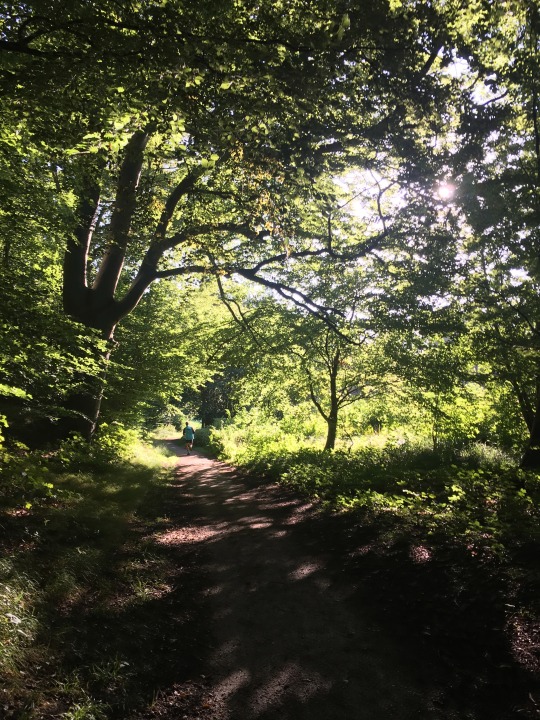
The second Sunday since my arrival, the first full weekend. In the morning Hans and I went for a run through the lakeside forest, the beauty of the trails makes the running tolerable.

Sunday evening, Hans and I went to an FC Copenhagen game. We played a Danish team from Southern Jutland and won 3-2 if I can remember. I can’t consider myself a sports fan, but I recommend attending one of these games if the opportunity presents itself. Being amongst the crowd of rowdy Copenhageners is a lot of fun. If you really want to get into it, figure out what the cheers are before going… and if you’re feeling confident, maybe book a seat in the rowdy section.
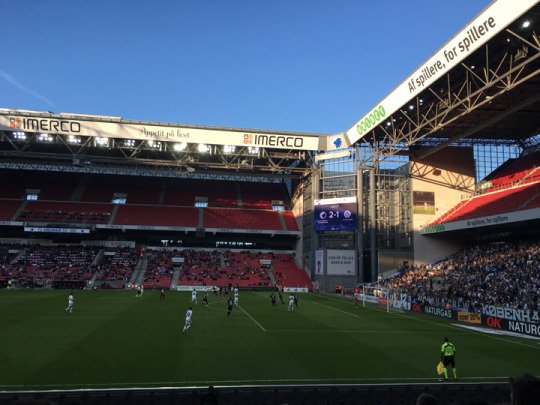
Another view of the stadium, rowdy section pictured to the right. They seem to have a great time swaying, jumping, chanting, shouting, and cheering to the beat of the drummer for the duration of the game.

I spent the beginning of Week 2 working on the two old bikes my family had in the side yard in preparation for biking to my first field study on Wednesday. The black one had a frayed gear cable and the grey one had two broken tires, a broken tire-lock, and a broken front-brake. I replaced the broken grey bike parts with the black bike parts and removed the front brake of the grey bike entirely. I really had no idea what I was doing, what seemed simple at first became a two-day project (a tiny handsaw and a hammer were involved in the operation, I lacked finesse and turned to forcing my will upon the old and rusty bike parts).
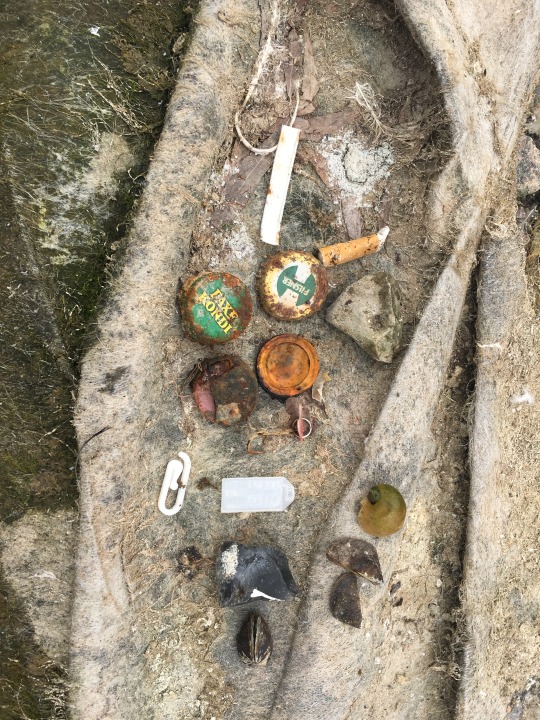
The next three photos are from my first field study with the Urban Ecology course. We traveled to four areas within the city: a shore-side seating area at Sankt Jorgen Sø, Axel Hedes Gade, a small park between some apartments near Axel Hedes Gade, and on a dock in Island Brygge. The field study served as an introduction to the Field Journal assignment we will work on for the entire semester.
Our professor simply asked us to fill the journal with any content relating to our observations of the environments we find ourselves in over our time abroad. Notes, sketches, photos, field samples, anything... we just need to mindfully observe each space. We focus particularly on 3 topics when assessing an environment: (1) Its pros and cons as a habitat for non-human organisms. (2) Pros and cons as a space for human beings. (3) Pros and cons as a space that influences biogeochemical cycles of the city and greater area.
Here is a sample of the garbage scattered around the shore of Sankt Jorgen Sø. I also found broken glass, old clothing, wrappers, bits of plastic, etc. I was also curious about the effect shoreline-type (concrete vs. vegetation) has on the presence of birds.
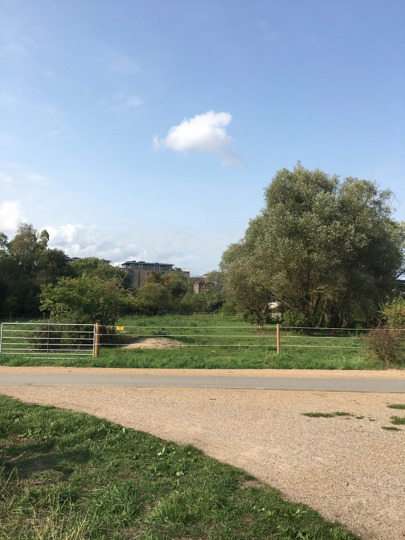
Axel Hedes Gade, the 2nd area that we met at. Our 3rd area is around the apartment buildings off in the distance. This road runs with many others through this very large field I believe to be part of Amager Vest.
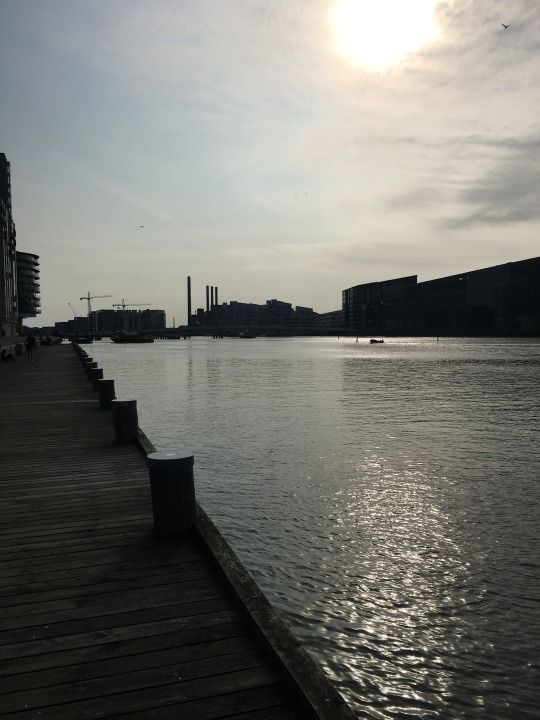
The dock within Islands Brygge we finished our field study at.
Going North (photo taken facing south) up the dock would take you to the Islands Brygge Harbor Baths, one of my favorite spots in the city (Be sure to go during the first 2-3 weeks if you’re here for Winter Semester, its only going to get colder and darker outside! WoOOo!)

I visited the Danish Architecture Museum with my 20th and 21st Century Danish Architecture class. We had an hour to be toured through the current exhibition “Welcome Home,” a historical survey of the Danish home.

I cooked a meal for my host family on the Friday of the 2nd full weekend. I picked up pretty much everything at Torvehallerne, the rest was stuff from home.
Trout stuffed with lemon, red onion, dill, and garlic... basted with a sauce made from butter, dark beer, and leftover stuffing. Artichokes filed with one of the many kinds of cheese I found in the fridge and garlic. I also made some caprese salad.
It was simple and delicious, my host family loved it... there were barely any leftovers between just three of us.

Saturday of full weekend #2. Stopped at the National Museum of Denmark for a few hours. If you really love museums, make this an all-day event... 4 hours only gave me enough time to somewhat thoroughly go through the 1st floor (there are 5 if I can remember).

Lur Horns
Nordic wind instruments. They were used to create an atmospheric background sound for Bronze Age rituals. All of these lurs were found in bogs and are from 1200 - 700 B.C.
This might be what they sound like.

Tirsted (10th century AD)
The plate beside the stone lays out an attempt to translate the inscriptions.
“Asråd and Hildvig raised this stone in memory of Frede, their kinsman. And he was then (the terror of men) and he died in Svitjod (Sweden) and was (the foremost of Frigge’s host); and then: all Vikings.”
Doesn’t make much sense, but this room was one of my favorite in the entire museum. About a dozen of these stones are laid out in the room. I read that when these were first erected they were fully painted in bright color. I find the way the words are etched and stained to be fascinating.

The woman of Himlingøje
From the 1st half of the 3rd century AD. 40-50-year-old woman. Within the woman’s mouth is a piece of gold, called a Charon’s coin. The piece was meant to pay for passage to the realm of the dead. Jewels, beads, bangles, rings, a comb, earthenware vessels, a bronze pail, a dish, ladle and sieve, glass cups, and a silver coin were laid among her. (Information from plaque)
This room and a number of others were filled with remains and the variety of items that were placed beside them at the grave.
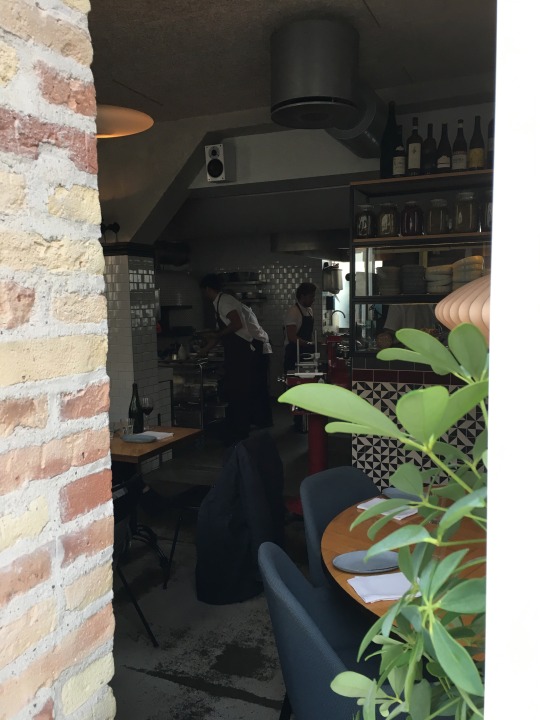
After the museum visit, I had dinner at BÆST, a restaurant that's whipping out freshly fired pizza, fresh veggies, and carefully crafted charcuterie and cheeses. A majority of the ingredients they use come from the eastern Farm of Ideas, a farm founded by Christian F. Puglisi, the lead of BÆST and others like Ralæ, Manfreds, Mirabelle... etc.
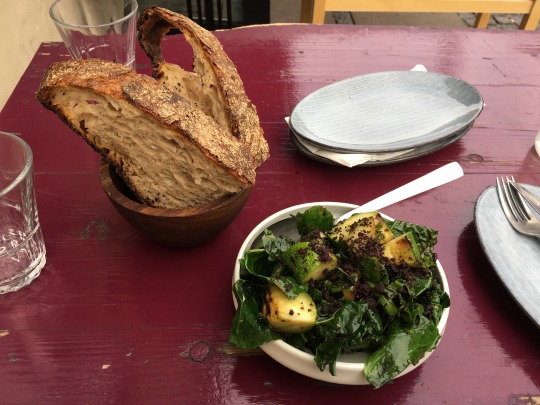
Swiss chard, Russian kale, grilled fennel, dried olives, and really really good ricotta. Some GOOD sourdough bread.

Margherita. Tomato sauce, mozzarella, basil. (This was good, but I’d get something with their charcuterie on it if I go another time.)

The view of Peblinge Sø from the bridge of Nørrebrogade. On a weekend night, get together some friends, grab something to go from the great variety of food stops nearby and head on over to the many spots that border these lakes.
I took a stop here after my dinner at BÆST, on my way back to Nørreport Station.

On my Sunday morning run, I found an apple orchard near my house. Off in the distance is a bunch of beehive boxes, some of which contain colonies.
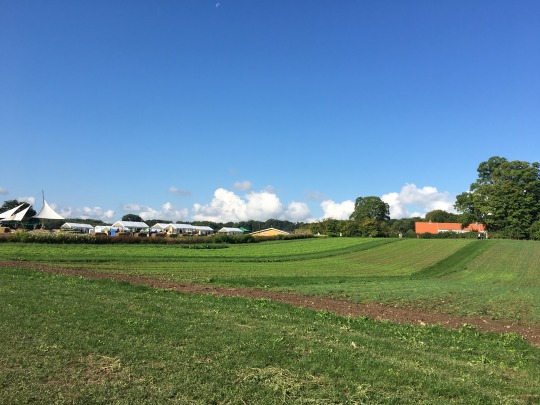
Aarstiderne Farm Harvest Market. A nice festival with food stands to showcase their fresh produce; tours of the farm; local artisans crafting things like chocolate, sea-buckthorn jam, charcuterie, clothing, coffee, etc; a produce market; and general good vibes. Its a bit quite a ways north but was really awesome, I recommend checking in this event and ones like it during your time here.
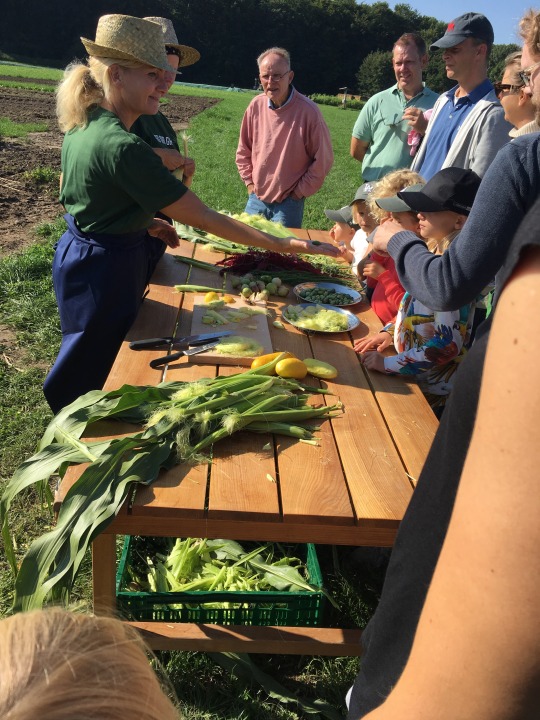
A stand near one of the produce fields. Showcasing some of the freshly picked produce.
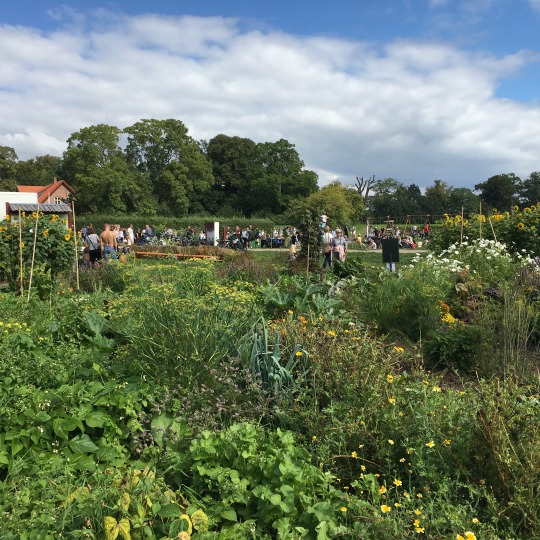
A view of the crowd amongst flowers and produce. This photo and the one below show two different farm areas, both containing pretty much the same vegetation. In this photo they are planting everything together. In the other, they are planting uniformly in rows... perhaps they are testing to see the two different methods effect on how well the plants do.


Ørstedparken a nice park near Torvehallerne. We went here for an Urban Ecology session, continuing our exploration of urban environments as a habitat, a human space, and an influencer of urban biogeochemical cycling.
This is one of many parks that were originally a part of the old defense fortification ring decommissioned in the 1870s. A section of the mote has become the lake and bastions have become small hills within the landscape.

The second field study, this time with my 20th and 21st Century Danish Architecture Course. This is Grundtvigs Kirke, dedicated to N.F.S. Grundtvig, built from 1927 to 1940. The architect is Peder Vilhelm Jensen-Klint... His son and his grandson were involved in the work as well. The church is a centerpiece of a village of similarly styled residential buildings and small storefronts. The style is a mix of Expressionist and Gothic architecture.
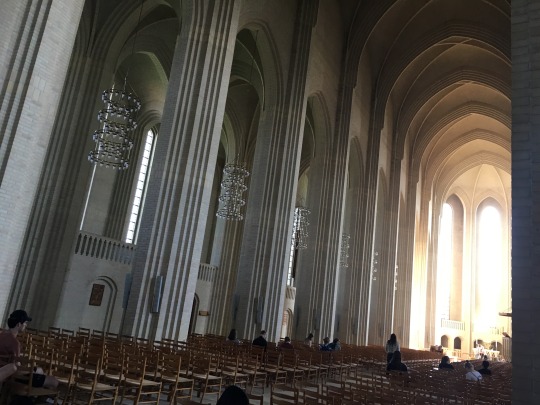
The glowing interior of Grundtvig's Kirke.

Bagsværd Kirke. Architect: Jørn Utzon (you know him, Sydney Opera House). We were to compare and contrast this church with Grundtvigs despite their great contextual and stylistic differences.
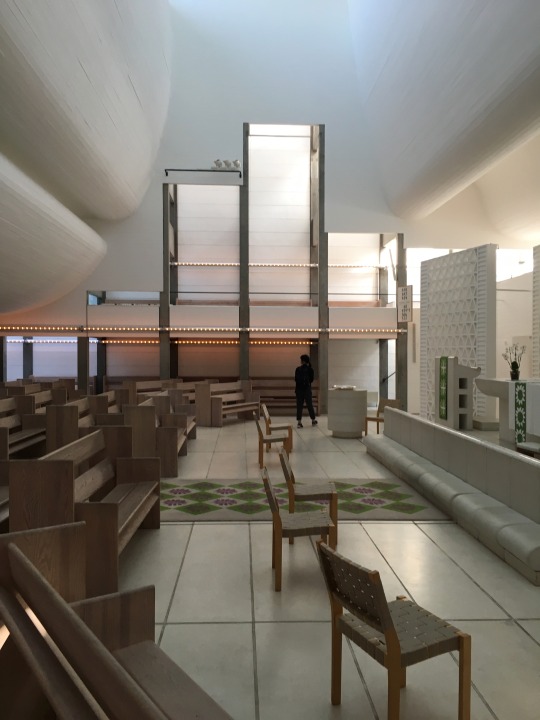
The greatest part of the interior is the vaulting, a sprawling wall of concrete curved into a smooth wave of linen-like white that softly carries light downwards into the room.

The natural lighting works really well with materials and colors. There is a cool, cloud-like softness to the otherwise clean-cut and industrial structure.
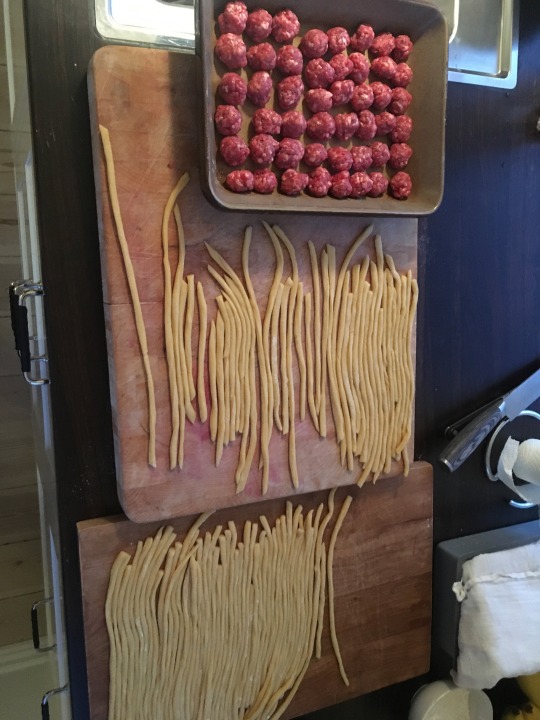
Last Saturday night, I decided to try my hand at making pasta from scratch. It was fairly easy, just 400 grams of wheat flour, 4 eggs, salt, and olive oil for the dough. I let it sit, rolled it out, and then cut it into strips. The small meatballs, or pallotine, are just beef, salt, pepper, olive oil. This was my inspiration, I am far from it.

Everything coming together. Pasta’s cooking in salted water, the red sauce has been cooking for around 3 hours, and the meatballs are frying in olive oil.
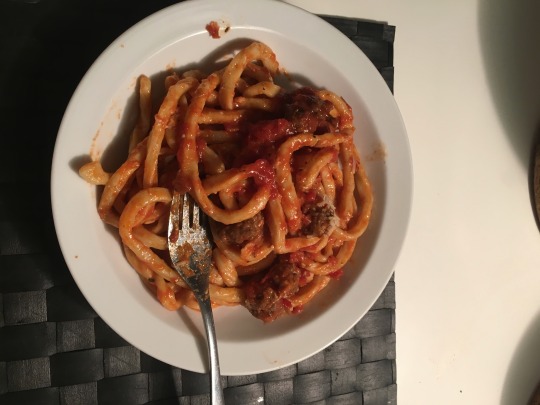
It’s not beautiful, but it was quite delicious. I’ll be ready for next time!

Prolog Coffee Bar over in Kødbyens District, the best coffee I have had in Copenhagen so far. 2-3 workers serving up stupid good coffee in the small alley-like interior amongst a number of other really cool food stops. I HIGHLY recommend coming here to get a cup and check out the other spots nearby.
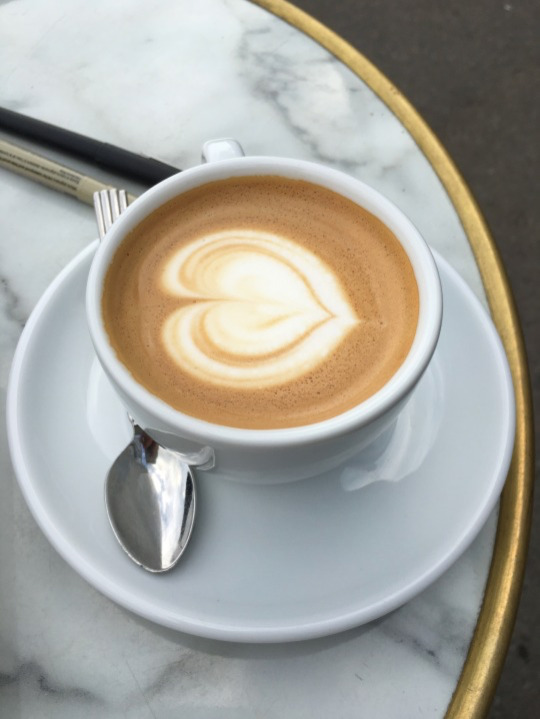
This is it. A cortado.
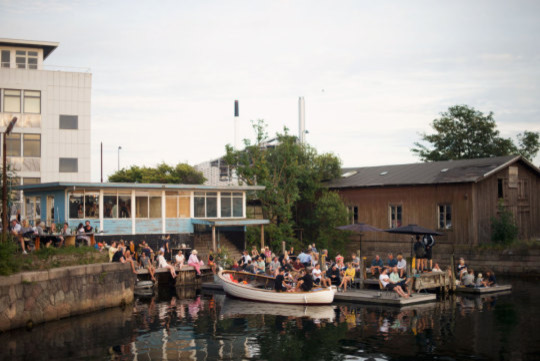
I did not get my own photo of this place, La Banchina, my current favorite spot in Copenhagen. The place serves up a variety of natural wine, beer, baked goods, snacks, and really good, creative meals out of this unusually wonderful place (the kitchen is in a mini greenhouse building). Take a dip into the harbor water, jump into their sauna (50 Kroner), and make some friends. I hope to find myself here many more times, even as the days become dark and damp. (This place is in its full glory during the summertime).
The surrounding area of Refshalevej is worth checking out on its own, I’ll be back to revisit the place in a post sometime later on.
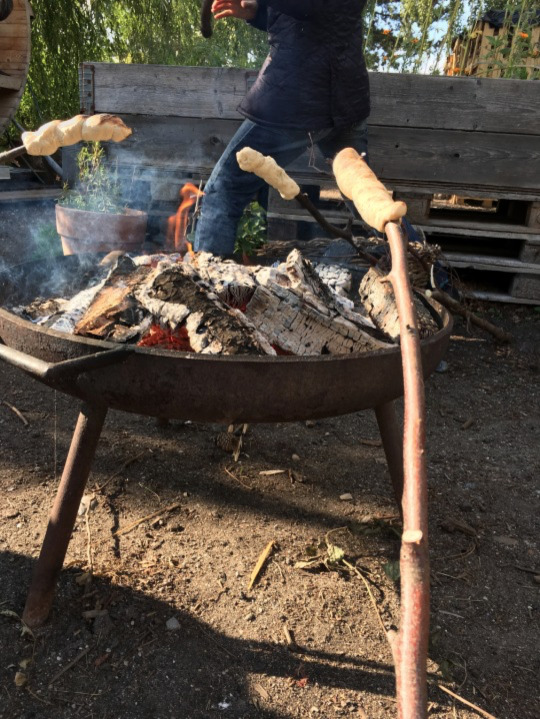
Everyone gathered around for some Snobrød, a Danish tradition of baking bread on a stick. This was available to everyone that stopped by, you just had to find your own stick... this beats roasting marshmallows.
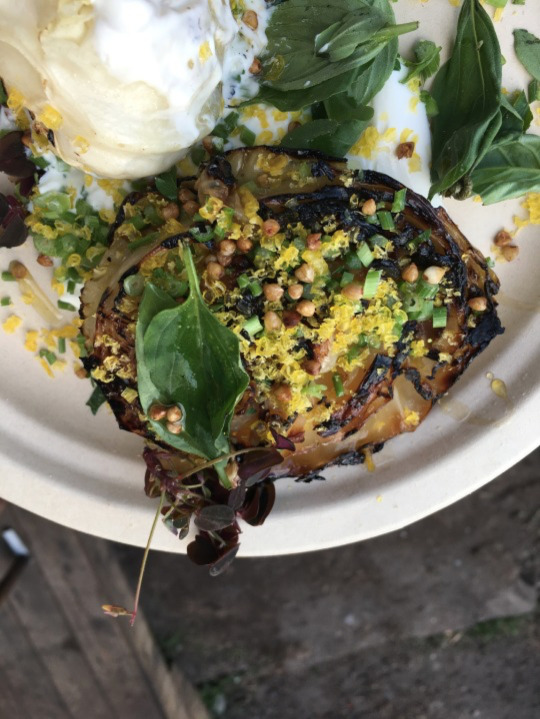
Cabbage, roasted buckwheat, cured egg, fresh creme, chives, and a couple other things. I started eating it before I remembered that I should take a photo of it.
There is never a set menu, they decide what to serve based on what's available and what's on their mind.

Sunset on Vejilesø near my train stop at Holte.
I’ll be posting about Core Course week next!
0 notes
Text
I go places, I eat things. Weeks 1 & 2
Torvehallerne in general

Inside of one of two buildings.

An apple I grabbed on my way home from the fresh produce market in between the two buildings. This thing is huge, it almost took me my full 20-minute train commute home to finish.

5 figs for 20 Kroner, good deal.
This place is wonderful. A dizzying combination of mini coffee shops, wine and beer vendors, seafood vendors and butchers, mini delis of different cuisines, bakeries, a cheese shop, fresh produce markets, tacos, and much much more (60+ stalls with special events happening multiple times a month). Right near Nørreport Station I often make the quick stroll over to grab some fruit before hopping on the train.
Hija De Sanchez (Torvehallerne location)

Left: Cheese, Top Right: Barbacoa, Bottom Right: Bean. Plus a necessary spoonful of some delicious pickled spicy bits. All for 100 Kroner. The three taco menu changes every now and then. They are rolling out tortillas from fresh masa on-site, they were the highlight. They also have
This is the first place I stopped the first Monday of the arrival workshop. This is one of the three restaurants from Rosio Sanchez, known best for her background as Noma’s Head Pastry Chef. She now has three of her own spots, her and her crew are serving out modern Mexican food that celebrates the beauty of Mexican culture with the city of Copenhagen. Amongst the crowd of locals and tourists, my friends and I filed into the nearby picnic benches to enjoy the amazing weather and equally wonderful meal.
I am really looking forward to going to her brick and mortar location over in Kødbyens, just look at the website to see the amazingness being dished out over there.
Christianhavns Bådudlejning & Café

Front view of the venue.

Left: Irish Coffee, Middle: Espresso, Right: Beer on tap, they have around 5-6 choices.
My friends and I ran into this cool little dockside spot on our way back from our unusual adventure through Christiania (I mentioned before they have good falafels, I found out this was not true, they do have really nice gardens and the whole story of Christiania is very interesting … so the visit was worthwhile).
I remember most people ordering a cheese or charcuterie platter (for a lot), they also serve sandwiches, salads, etc. The three of us just ordered some drinks. We sipped along and talked as we watched boats float by and under the nearby bridge. The place seemed to have been setting up for a music performance and were preparing a vertical rotisserie. Perhaps I will come by again as they appear to have events quite often.
DØP

Goat Sausage with the Mashed Roots
“Our mash is made of parsnips, potatoes, and kohlrabi and traditionally served with mustard, ketchup, and beetroots.“
One of the dog joints that set up in the streets. Good variety and serving options (vegetarian-friendly). All organic ingredients and a respect for Danish tradition, they pride themselves on “optimizing” the traditional hot dog stand. I don’t often eat sausages, but when in Copenhagen…
Slurp Ramen Joint

Closest is the Shoyu Ramen, always on the menu. Very hearty broth, slices of pork, marinated soft-boiled egg, bamboo shoots, fresh herbs.
“Soy sauce based ramen topped with chashu (pork), egg, cep puree, spring onions, menma, and mitsuba (contains gluten, fish & shellfish)”
The other one is the Miso Ramen, a buttery and subtle broth. This was the special, which changes every now and then. There is also a special appetizer, it was fried chicken when we went.
Not pictured is the Vegetable Ramen, the best out of the three in my opinion. Much lighter but with no less flavor, major mushroom mojo.
“Mushroom based ramen topped with roasted oyster mushrooms and portobello mushrooms, raw red onions, egg and seasoned salad - (contains gluten)“
The beer pictured was really good too.
Best place I’ve been to so far in my two weeks. One of the most delicious meals I have ever had. High quality ingredients sourced from DK and Japan, everything is made from scratch for a reasonable price. Philip Inreiter is the big dog (other than Norman) of the shop, who has spent time in Noma and Ralæ in Copenhagen and under world-class ramen-masters during his time in Japan. Everything about this place is just awesome. You may have to wait a little bit, but it is so worth it.
I personally recommend going for a swim over at Islands Brygge harbor bath or similar before lunch. Build up an appetite and a longing for some hot, rich, and no funny business ramen as you swim through the (pretty cold) harbor waters.
Ranee’s

Seared Ahi-Tuna with a bunch of fresh herbs and spices. A heavy combination of citrus, vinegar, fish sauce was in the mix as well. Paired with vegetables, most of which I have never seen before. Sticky rice and Oolong tea also part of the meal.

Red Curry, lots of vegetables. I don’t remember much else, but it was also heavy on the fish sauce funk.
Solid Thai food from family-run restaurant. I really liked all the artwork hanging on the walls and the neighborhood the place as in, will be exploring the area soon (by Nørrebro, lots of places to go there). I can’t get much info about this nice little restaurant as most of it is in Danish, but if you are looking for some quality and fresh Thai food this isn’t a bad place to start.
Democratic Coffee (Public Library Location, they have a new location opening on Viktoriagade 19)

Front of the shop, I always get the espresso. The entrance to the public library is right behind me. The interior of the cafė and the library are connected.
Very close to DIS classes, a GREAT place to pick up some coffee and a croissant (almond croissant, perhaps) to do some studying between classes. The shop is connected to the public library that provides even more study space. Keep an eye on their Facebook page for events and important info (when pastries are coming fresh out of the oven, special items).
0 notes
Text
The first week, Aug. 26

(San Franciso Airport: the gate and the plane I took to Denmark)
I arrived at the airport at 2 PM, my bags draped around me as I shuffled into the San Francisco airport. I yelled a quick goodbye and said thank you to my dad, who was being harassed by a very angry parking guard threatening to give him a $400 ticket for stopping on the crosswalk to drop me off. He waved back and I made my way forward to begin my adventure, feeling the first tinge of uncertainty and excitement as I went through the giant revolving doors. I checked my bag, paying an extra $50 because I was 5 lbs over the limit and went through customs. I had some time to spare at the gate, occupying with myself with food and people watching.

(MumFresh Vietnamese Eatery @ SFO: The Chicken Dumpling Noodle Soup)
I flew for 10 hours from SFO to Copenhagen Airport. I read until I became too sleepy and watched a movie until I landed, I figured that any sleep would make it more difficult to adjust to the 9 hour shift (I think I was right). I arrived at 13:00 (4 AM Pacific Time) in a sleep-deprived daze, I mindlessly floated through International customs (very easy in comparison to US, they are friendly too!) out of their airport and toward the hotel all DIS students were to meet at.

(My new home)
I was picked up and brought to my new home, drunk with sleep deprivation I spent the rest of the evening with the daughter of my host parents. We made a really fast dinner, went on a walk, and I unpacked. I went to bed at 8 with no resistance, I desperately needed sleep so my brain could work when talking with my host parents for the first time (was having a hard time remembering what I was even studying here in Denmark).

(The extraordinarily green forest just a few steps from my home, good scenery to motivate oneself to go on a run)
While I went to bed easily, I jolted “awake” at 3 AM. Confused and frustrated, I tried to use all my might to force myself into sleep to no avail. I sat around my room from 4 AM to 9 AM, when my family woke up and we had our first Sunday breakfast. We sat together over a variety of cheeses, biscuits, breads, pastries, yogurts, fruits, and a pitcher of coffee. The jet-lag fogged over my mind throughout breakfast and into the tour of Copenhagen wh went on together. My brain could not process the beauty of the city and the fact that I will be studying here for the next four months, the excitement did not register. I could not process anything; I got a good look around but ended the day with little to talk about (or remember) regarding what I had seen. I did have my first bit of Smørrebrød for lunch, two of the classics, herring and potatoes. I regret not getting photos and working to remember the ingredients, I will need to work on this through the semester.

(Frue Plads or The Square of Our Lady... view of Copenhagen University)
Day two marked the fading away of my jet-lagged haze and the beginning of the DIS Arrival Workshop. With speeches and opera performances at the Royal Danish Academy of Music came new acquaintances and conversation. In between Homestay network meetings, and other such things I wandered through the unfamiliar streets of Copenhagen. I walked and walked, watching bicyclists young and old flowing in and out beside me, families and friends taking a stop in their day at the local café, friendly conversations came across my ear in a variety of languages. The city was full of people enjoying the bright sun and the refreshing breeze, the beautiful weather reflected the energy of the city and its people. I’d sit and watch each individual carrying along with them the life of Copenhagen as they went about their day. I watched a child biking haphazardly through a busy street to school as her unconcerned mother trailing behind gives her words of encouragement. My eyes caught on to a bright bushel of flowers picked fresh from the market carried by an old man along with a basket of fresh fruit, he was likely on his way to his lady. I watched as Danes my age zipped by in groups as streaks of flowing glowing gold and shiny brown hair, carrying along their animated conversation and bright laughter as they make their way to a park to meet up. Locals, tourists from everywhere, immigrants, everyone is out and involved, few are closed off beneath the hoods of cars. They fuel the beauty of the city, the people fill the cobblestone streets laid out in between the quaint and the monumental buildings. In each of these buildings are more people fueling the city. I walk by bakeries, cafes, restaurants and take-aways, offices and shops, studios and museums overwhelmed by the experiences available beyond each doorstep. The city, Denmark, and beyond will be my classroom for the semester and aim to do my best to go head first into every day I am here. I look forward to sharing my experiences as I travel, study, learn from friends and faculty, eat, observe, and explore each and every day.

(The Garden of the Royal Library)
0 notes
Text
>24 Hours Till Departure: Mountain Biking, Quicksilver Park, Sustainability

Entrance to Quicksilver County Park

Remnants of the New Almaden Mine

The remaining foundation for the components of the Santa Isabel Shaft engine.

Photo from 1885 of the Santa Isabel Shaft engine room, you can see the granite foundation then vs. now.
...
Yesterday I went for my last mountain bike ride of the summer. Mountain biking is one of the many ways I like to get my daily exercise and time outdoors. I am grateful that I’ve been able to hit the trails with friends and family quite regularly lately. I most often visit the trails dispersed among Quicksilver County Park, a few minutes-drive southeast of my home in Almaden. I’ve grown up riding the route and have come to appreciate it as a quick escape from the suburbs and bustle of the surrounding south bay area city traffic. Before Quicksilver County Park was the pocket of nature it is today, it was the site of the New Almaden Mine, a major source of mercury-rich cinnabar ore operating from 1847 to 1976. Along the trails, remnants of the multi-million dollar operation remain, slowly falling apart amongst the forest and wildlife that has reclaimed the land. I find the land’s drastic transition from a 129 year old major mining operation to a county park enjoyed by generations of families year round to be fascinating.
I think the transformation ties in somewhat nicely to the idea of sustainable development, defined by the UN World Commission on Environment and Development as “development that meets the needs of the present without compromising the ability of future generations to meet their own needs.” While the mine operations were very likely to be unsustainable and under-regulated (i.e. major mercury contamination), the land was successfully redeemed through cooperation between the CA Dept of Toxic Substances Control, Santa Clara County, and other government agencies. Through the history of my local park, I catch a glimpse of what it means to care for the local community, natural environment, and the balance within and between the two. During my time in Denmark, I hope to really begin to see more of what it really means to be Sustainable, what it takes to strike a balance that supports “ecological, human, and economic health and vitality” by intelligently utilizing the finite natural resources available to us. Denmark as a leader in the movement for a more sustainable future is well known and I look forward to learning more about the role that I can play in the worldwide effort through my classes and adventures.
These are the classes that I am enrolled in.
Sustainable Development in North Europe Section B, my core class. I look forward to this class as the primary source in building my understanding of sustainability. I’m also pretty stoked about getting to visit the various sites around Denmark, westward in Sweden for Core Course Week, and down south in Germany for the long study tour.
Environmental Philosophy. I really enjoyed what little Philosophy I have taken so far at Cal Poly. I’m glad to take get a little bit more and to have it tie in well with my core class. I recognize a few of the authors from the course readings, it will be great to discuss what we read from Muir, Thoreau, Schopenhauer and the many others on the syllabus.
Urban Ecology. I am interested in learning about the ties between nature, humans, and the urban environment. What I learn should definitely be applicable to Silicon Valley, the ever growing and changing world capital of technology.
I will also be taking 20th and 21st Century Danish Architecture (GE Credit) and International Business Negotiations with Copenhagen Business School (Credit for my Business Degree).
In less than 24 hours I will be on my way over to Denmark to begin my four-month adventure. I aim to take in as much as I can from the variety of experiences presented to me. I am looking forward to it.
0 notes
Text
Aug. 6th, 11 Days Till Departure: Food

Everything all ready.

Big dough for a large pepperoni.

Laying down the crushed tomatoes. Didn’t get a photo of the finished product.

Pesto, Goat Cheese, Basil, Figs, Olive Oil, and Garlic
...
In recent years it has become somewhat of a tradition to hold intermittent weekend pizza nights for friends and family at my house. Flour, dough, toppings, and sauces are flung about in a hectic celebration of most often nothing-in-particular, resulting in messy but relatively delicious pies and a haphazard kitchen left to deep-clean and organize at the end of it all.
Food, pizza in this case, is a memory. With each imperfect dough I slide into the oven, a new memory slides into my mind in parallel. The good times and lessons learned (pizza-lessons and beyond) come out as I recall the crackle of the cooked dough, the stretch of mozzarella, the smell of flash cooked olive oil, garlic, and tomato, the many imperfections and improvements that come with each attempt. I savor the whole experience as this will be the last pizza night before my departure.
I have a lot to learn. Regarding food and with life in general. My interest in cooking and food culture has just begun to develop, my skills trudging along in tow. With each pizza night, I capture what I have improved upon, in pizza making and in my character. With improvements in organization, prep, and execution in cooking comes improvement in organizing, preparing for, and enacting my academic and personal goals. If I can’t organize the simple pizza toppings and ingredients, how can I expect to keep life organized? How I share what I cook for friends and family reflects how I have grown as a person, how well I can bring people together, build friendships and learn from them. Introversion can be overcome at the dinner table. You can’t have a bad time with those that are sharing a damn good meal with you. This is how I hope to connect with and learn from those I meet in Denmark, over some amazing food.
The food scene in Denmark’s capital city and beyond has seen a recent boom thanks to the creation of street-food strongholds such as Torvehallerne in 2011, the widespread focus on local and seasonal high-quality ingredients, the culinary wildfire stoked by the extremely successful Noma, and much more. Food is one of my primary motivators for choosing Denmark, I was enthralled by how they prepare, present and share the amazing food I saw in the articles read and videos watched. I don’t know too much about Denmark, but I’d like to think that I do know at least a pinch about good food. A love for food as common ground with those I will be meeting on nearly the other side of the globe is a comfort and point of excitement I am holding on to in the days leading up to my departure.
Here is a list of a few of the places I found or have been told about. I’d like to eat at a few, maybe just stroll by the front entrance of some of the others.
Aaman’s Deli, Kødbyens Fiskebar, Hija de Sanchez (two locations, restaurant and booth in Torvehallerne), Sanchez, Hot Dogs (All over the place), La Banchina, Kebabistan, MaoBao, Pompette, Lille Bakery, Gasoline Grill
I am also looking forward to checking out the Copenhagen Cooking and Food Festival from August 24th to September 2nd.
0 notes